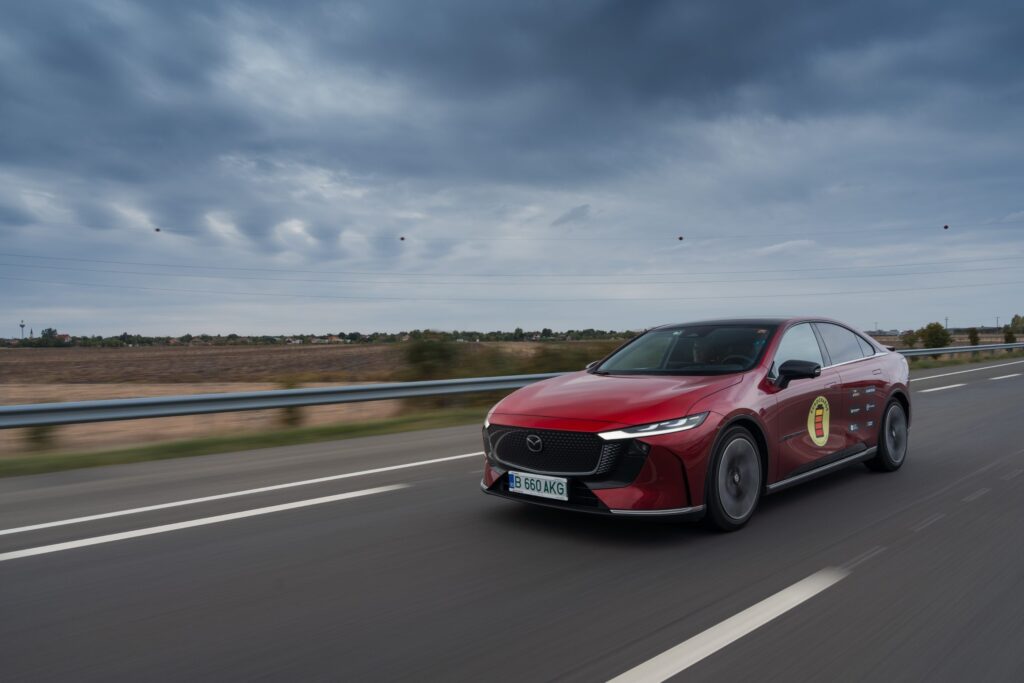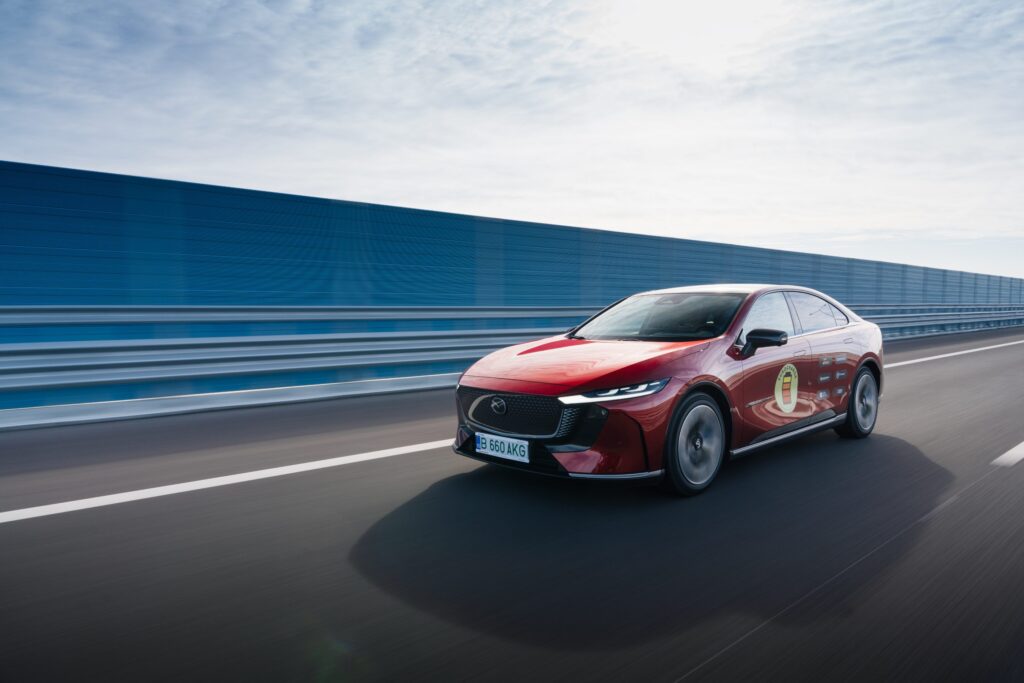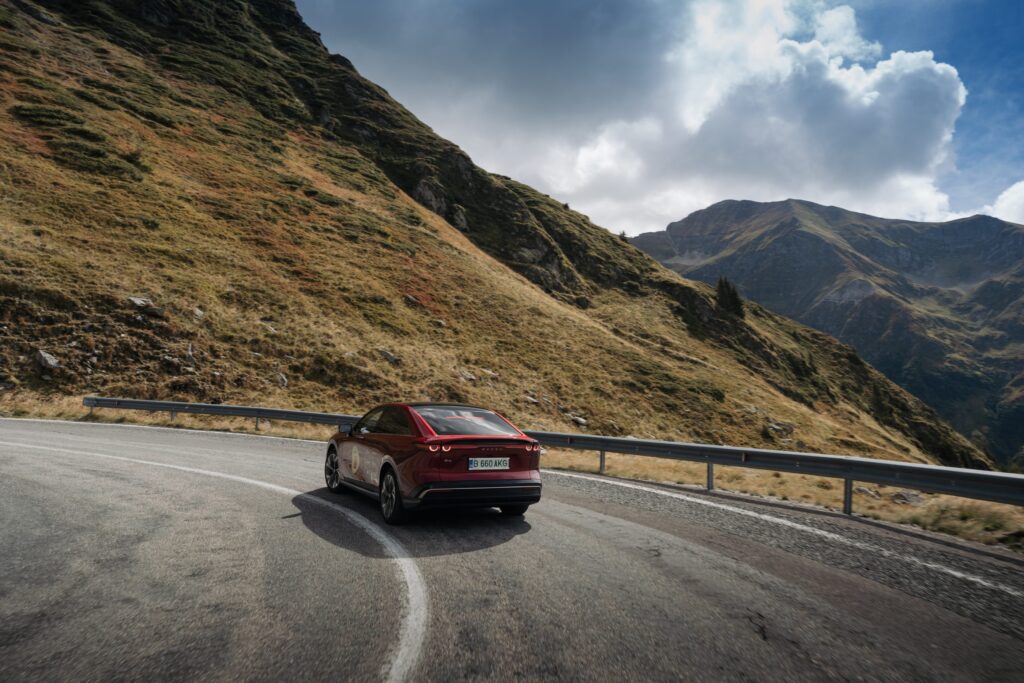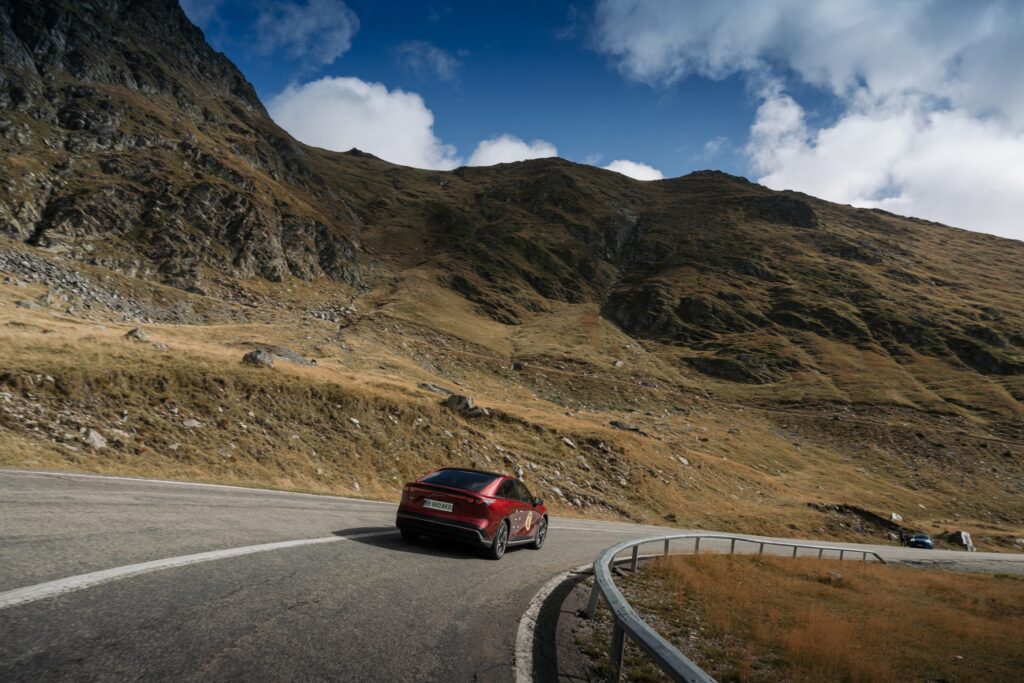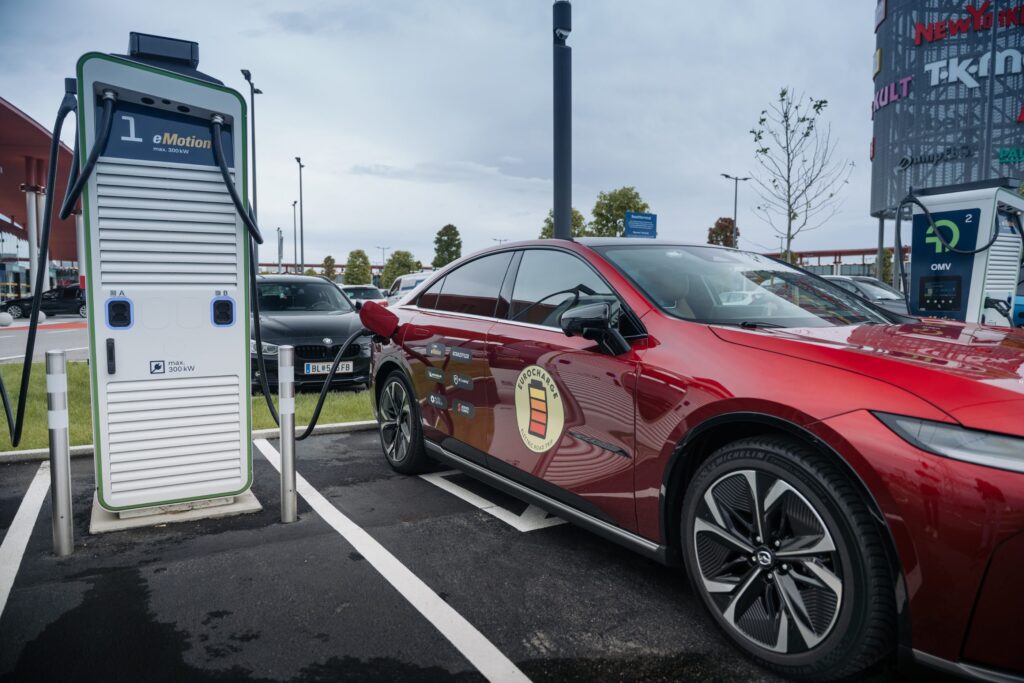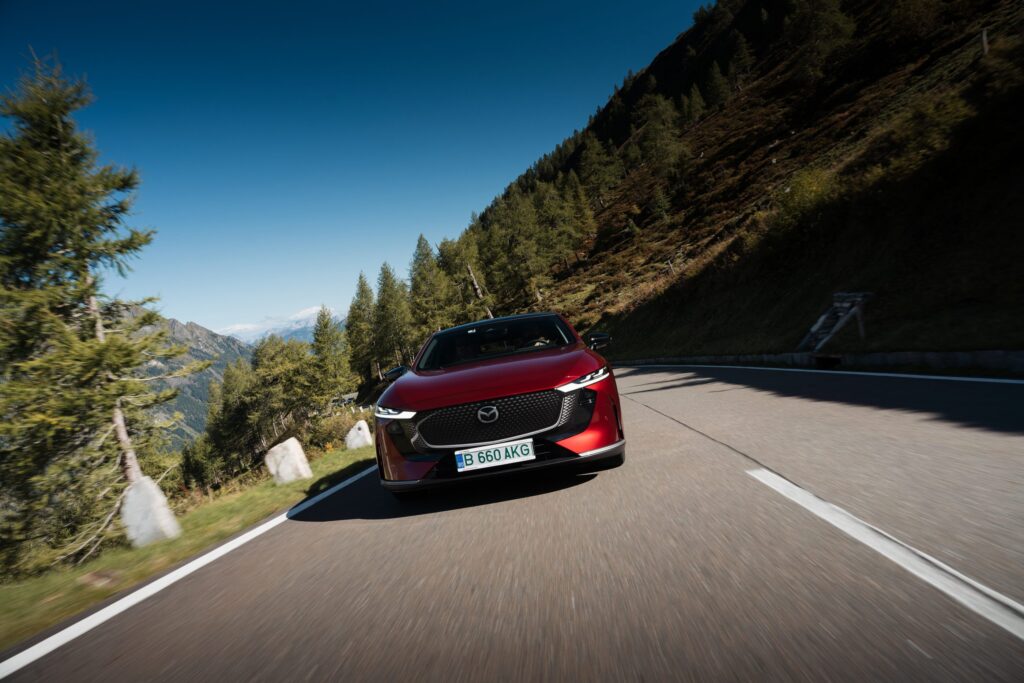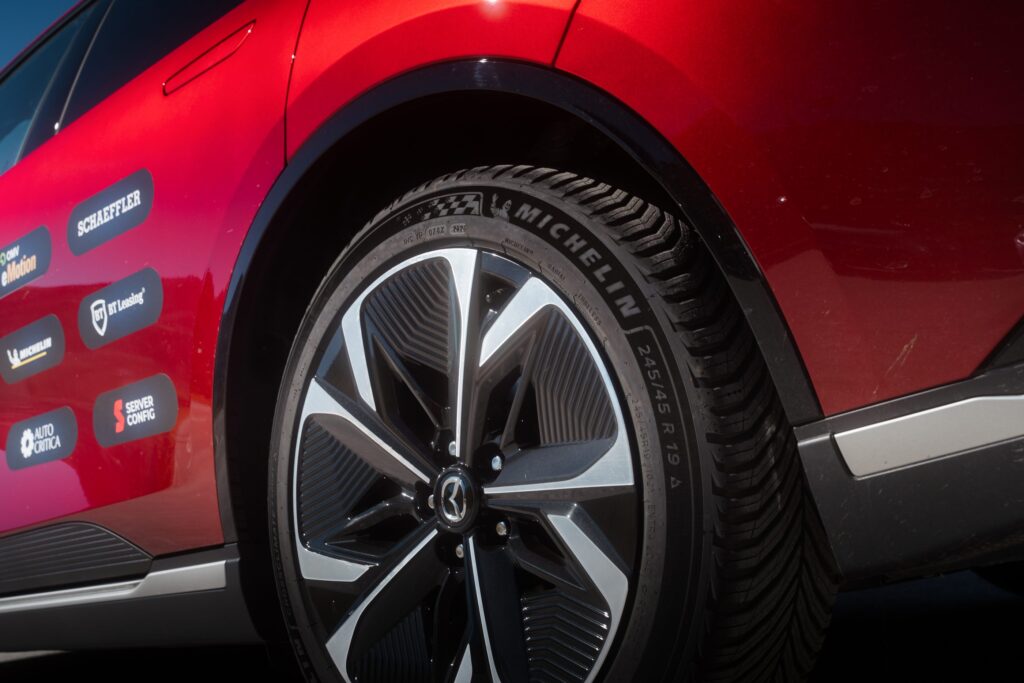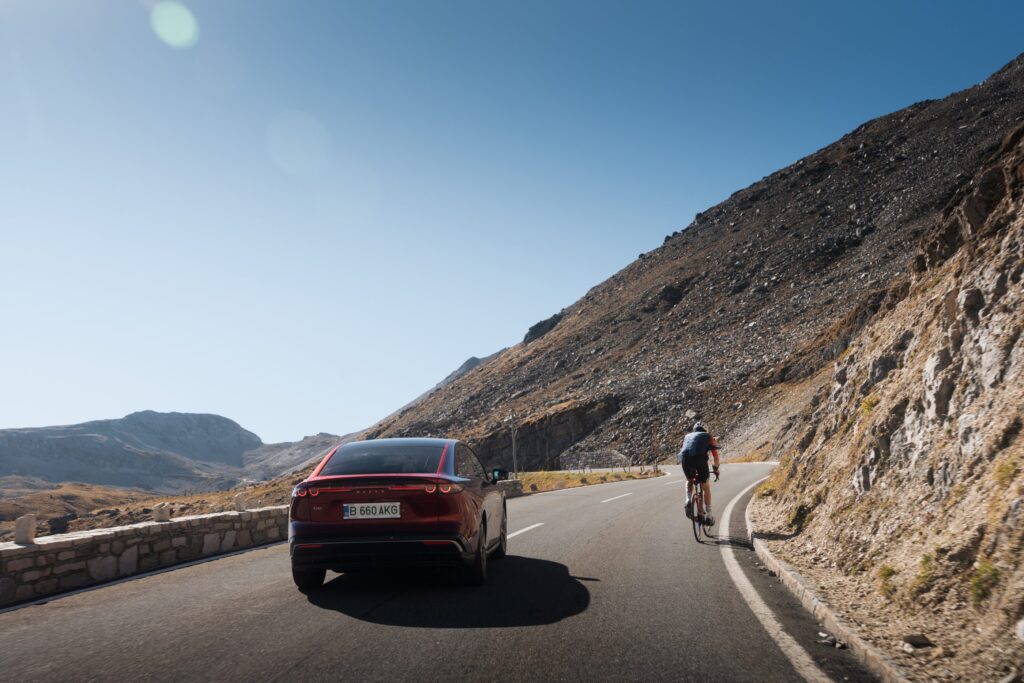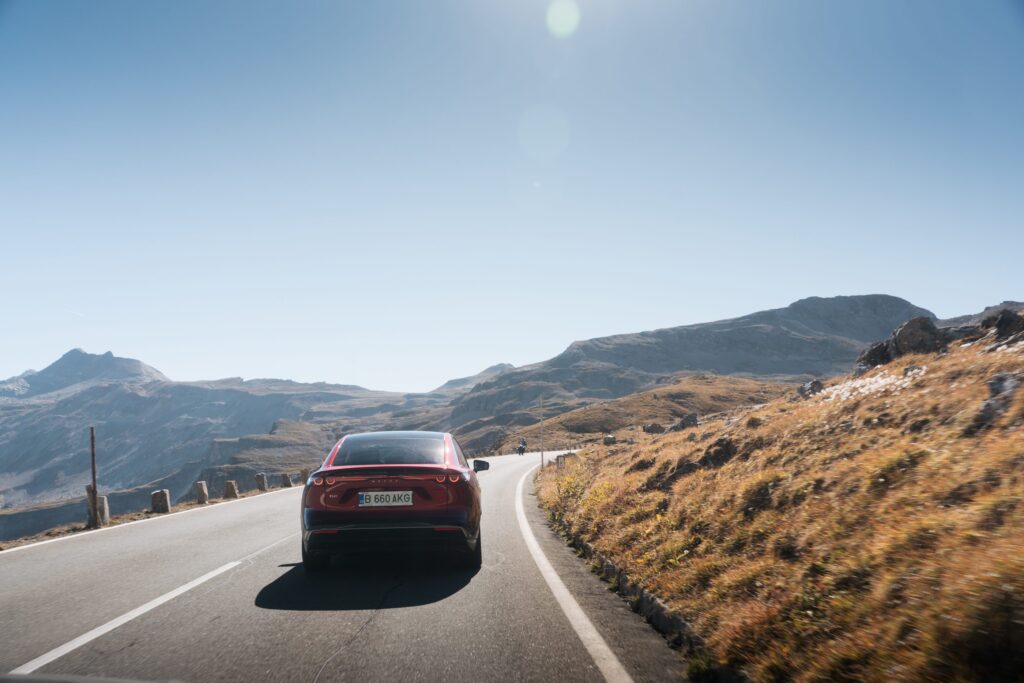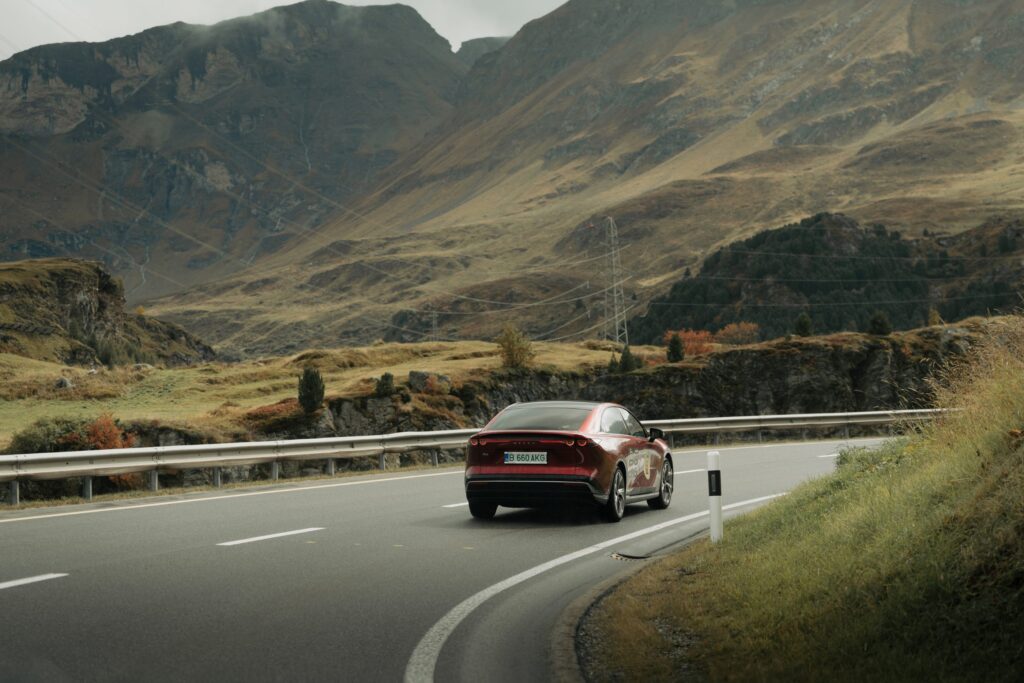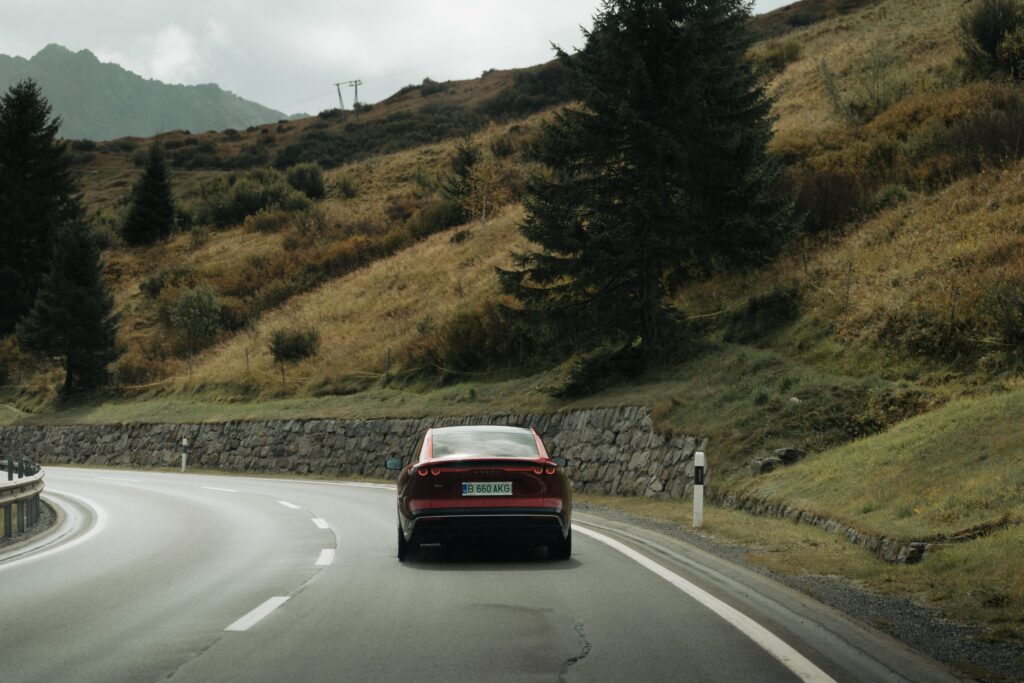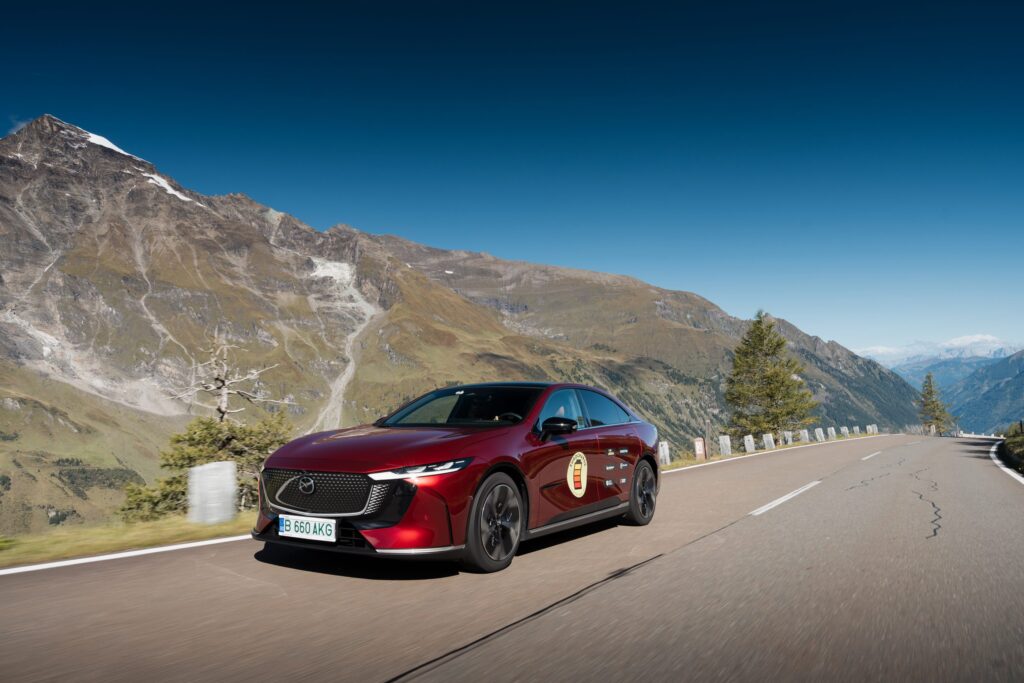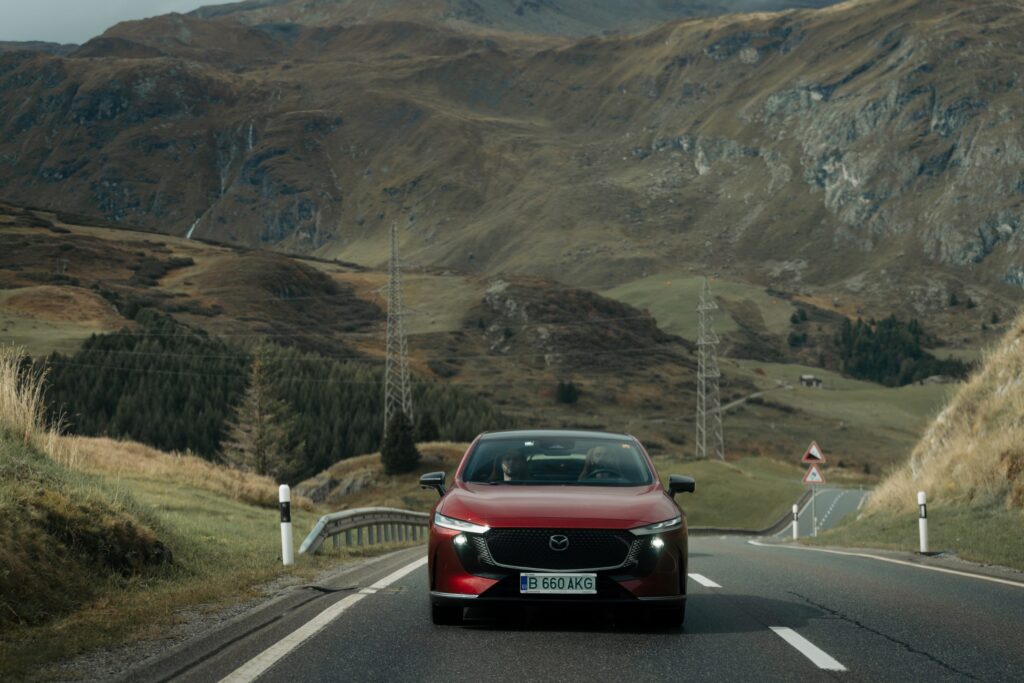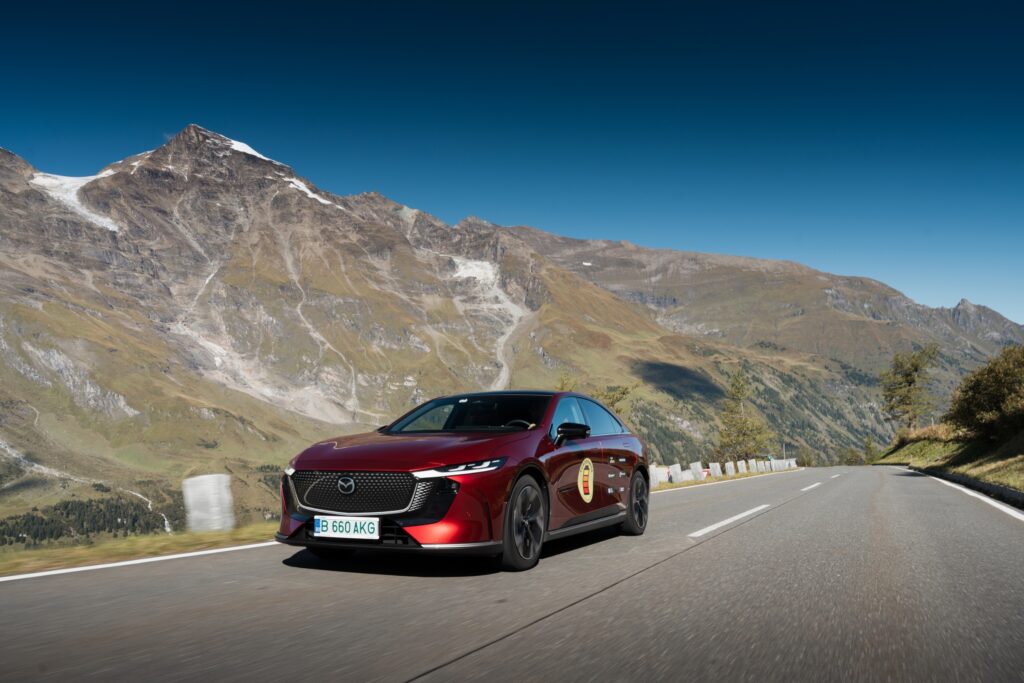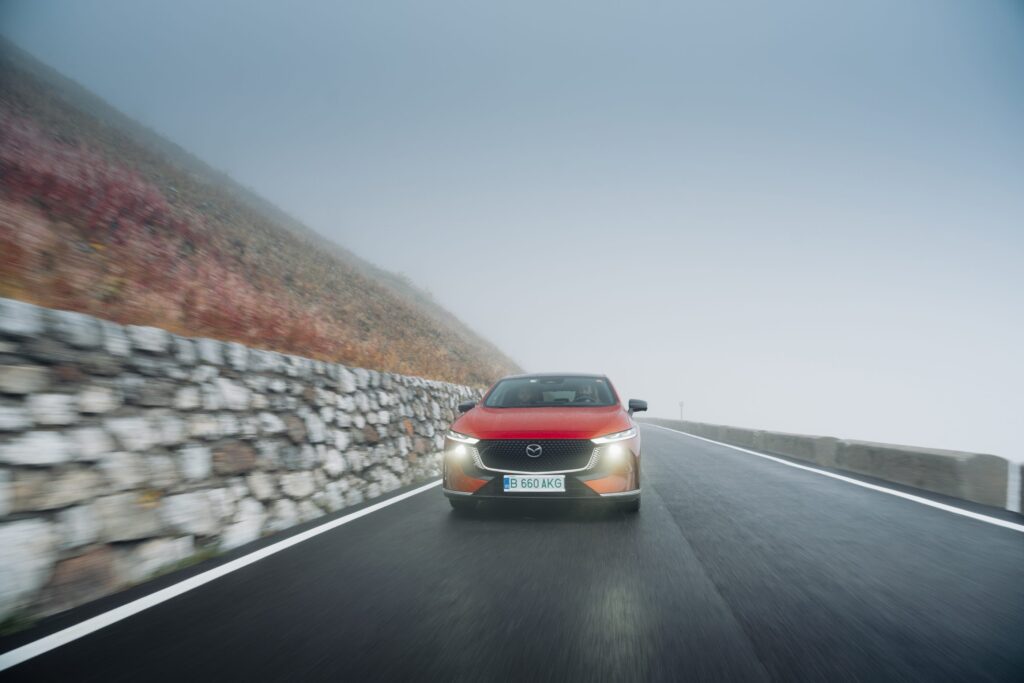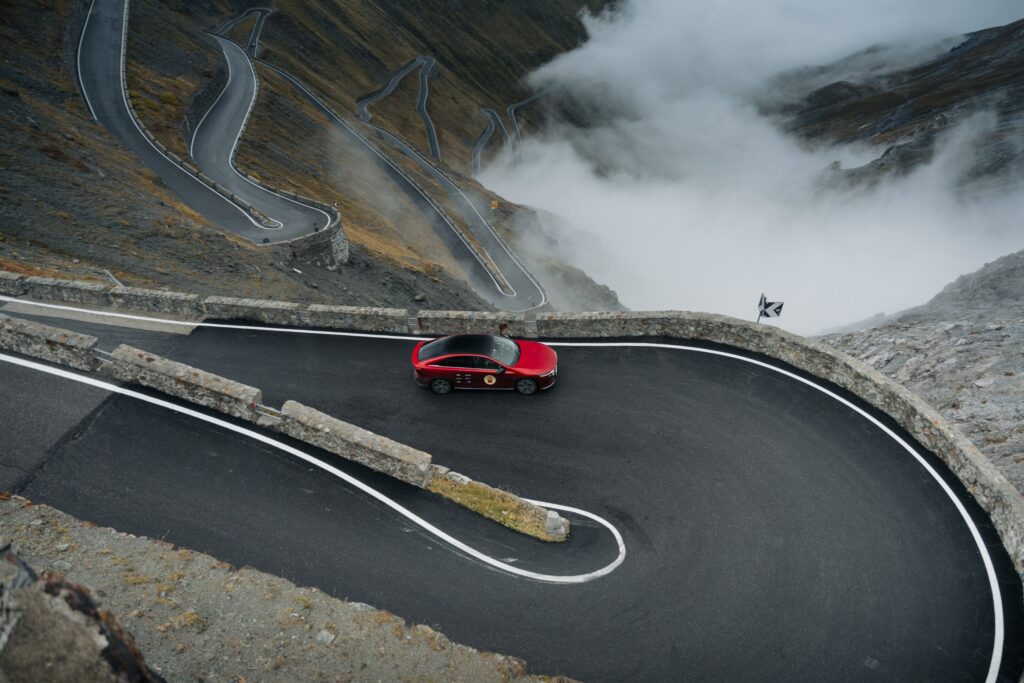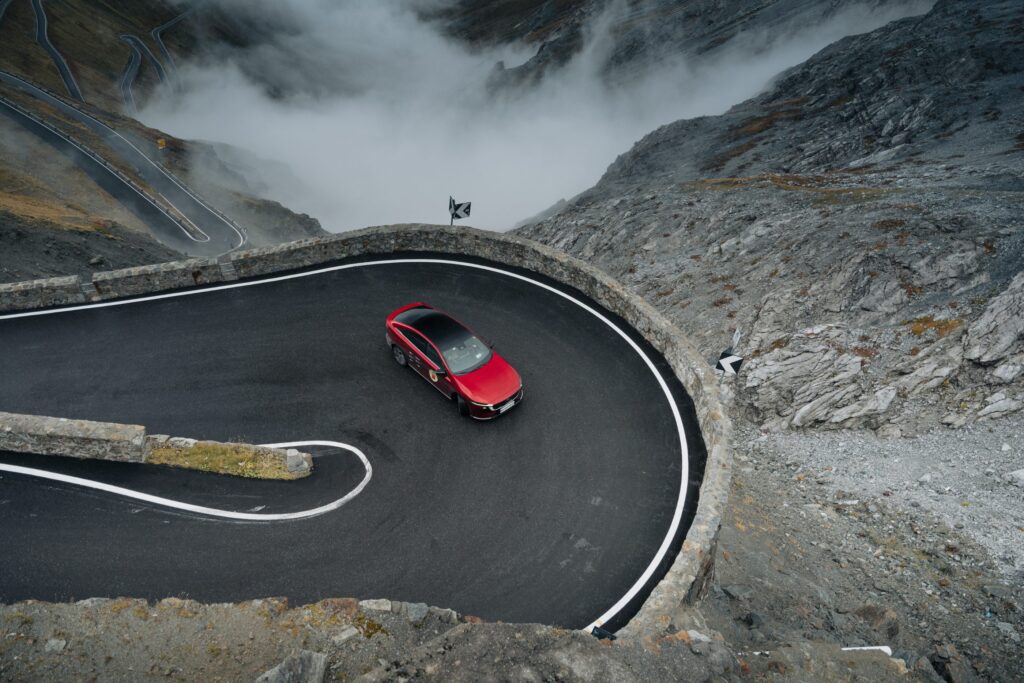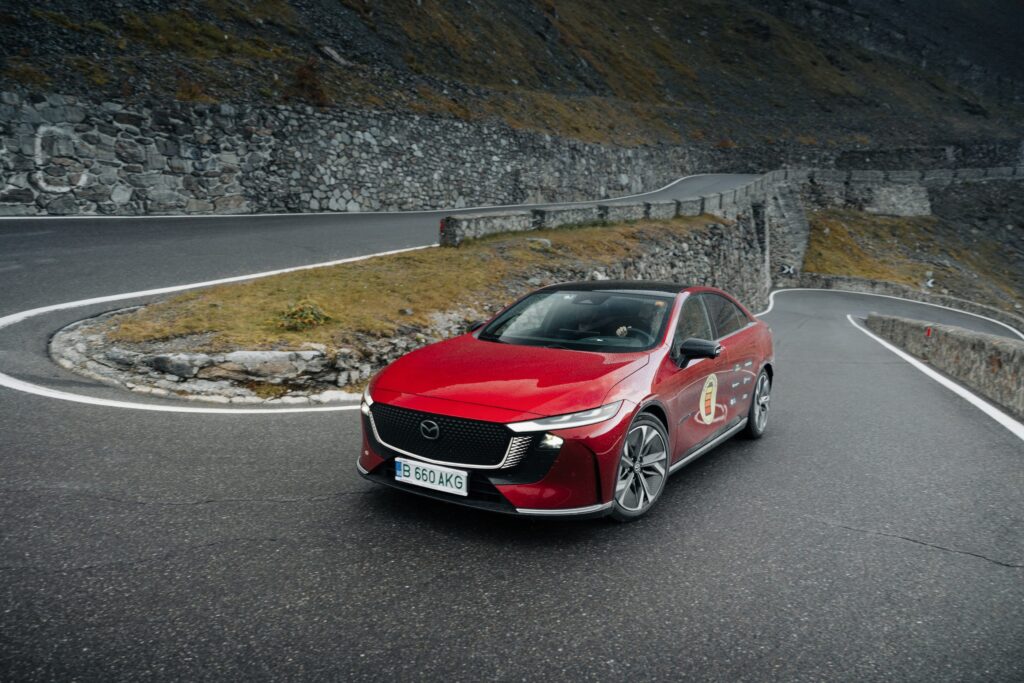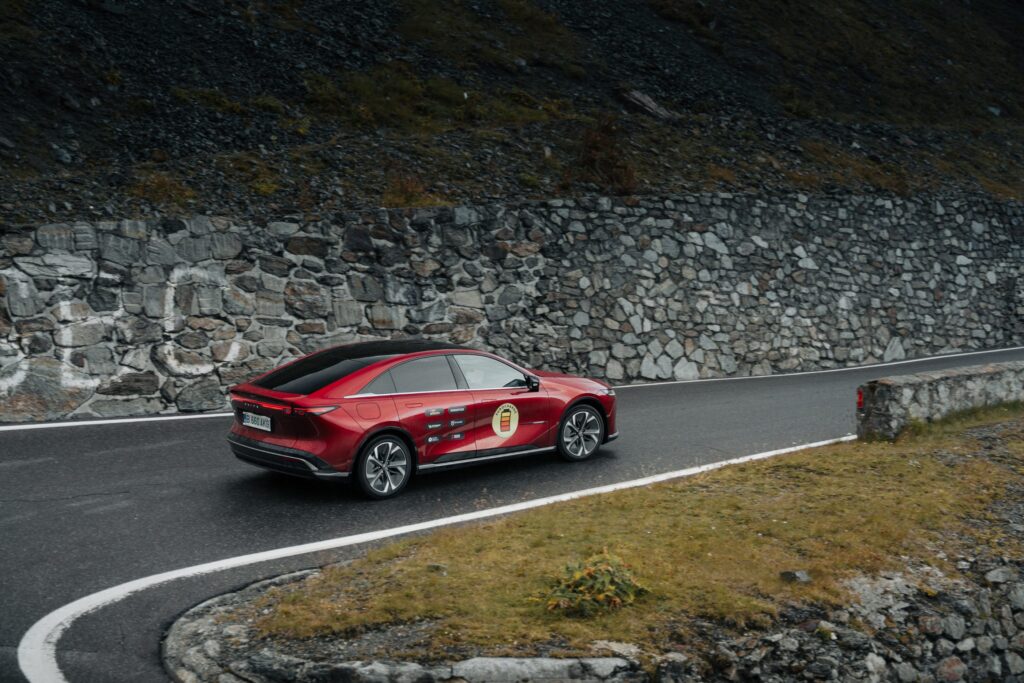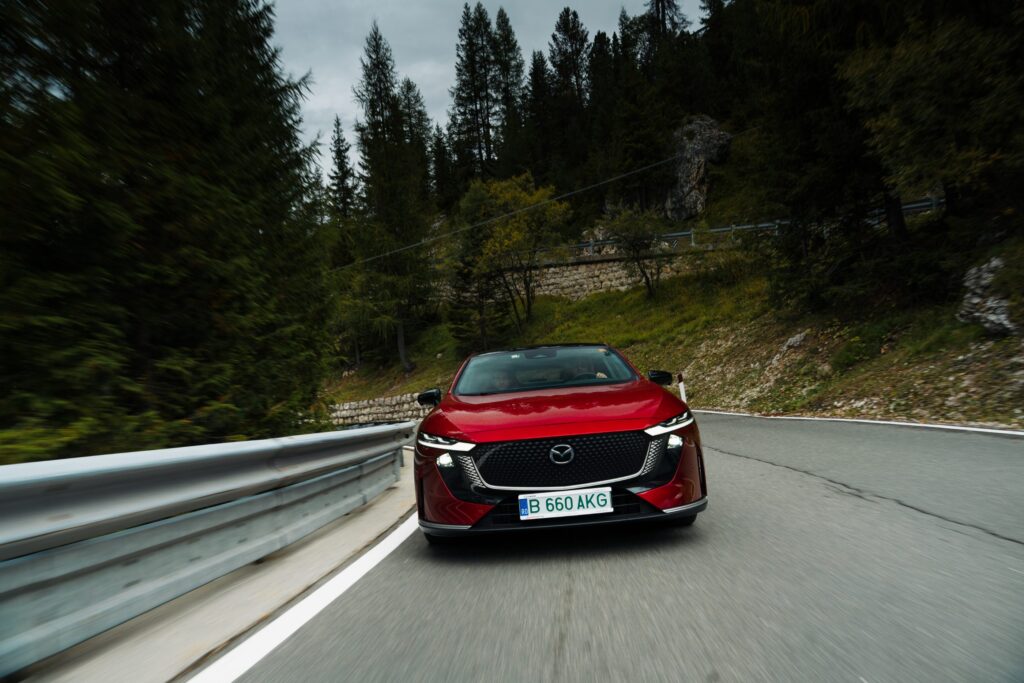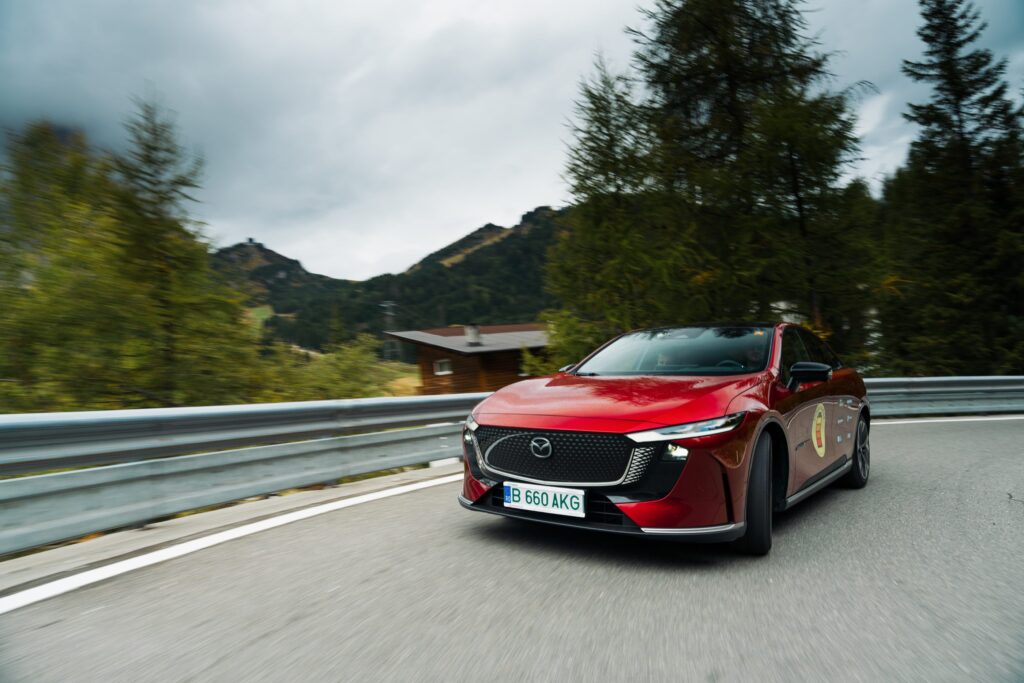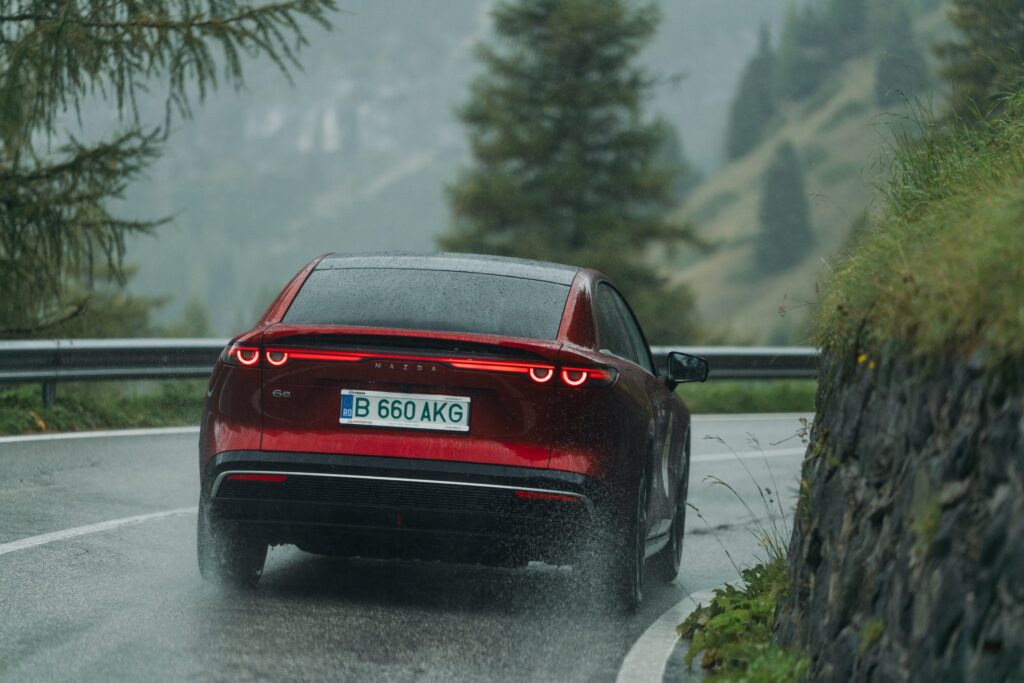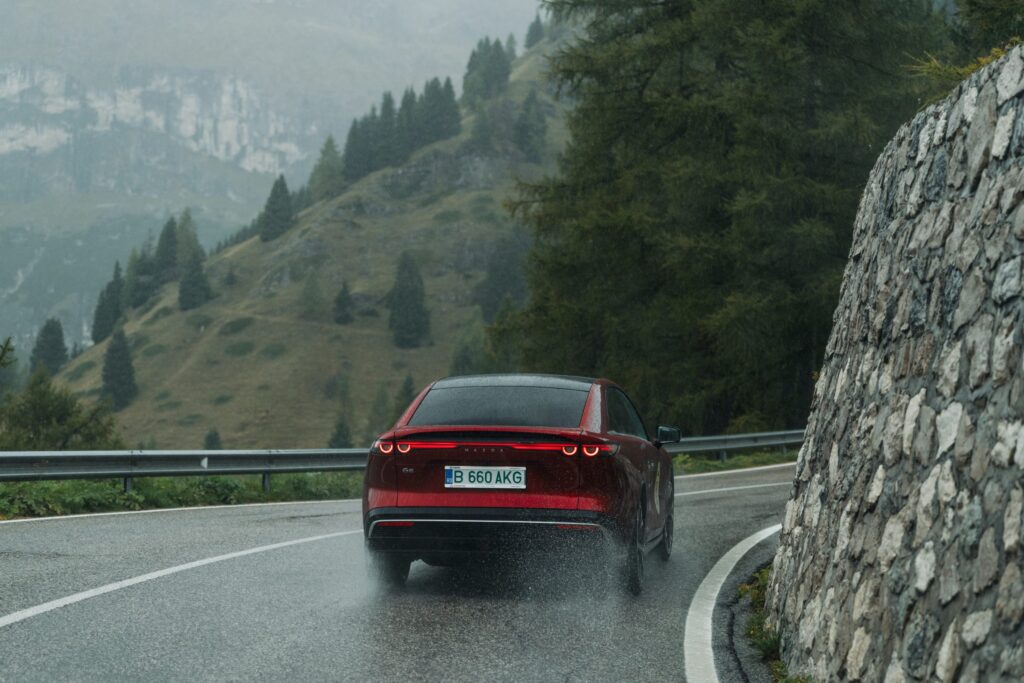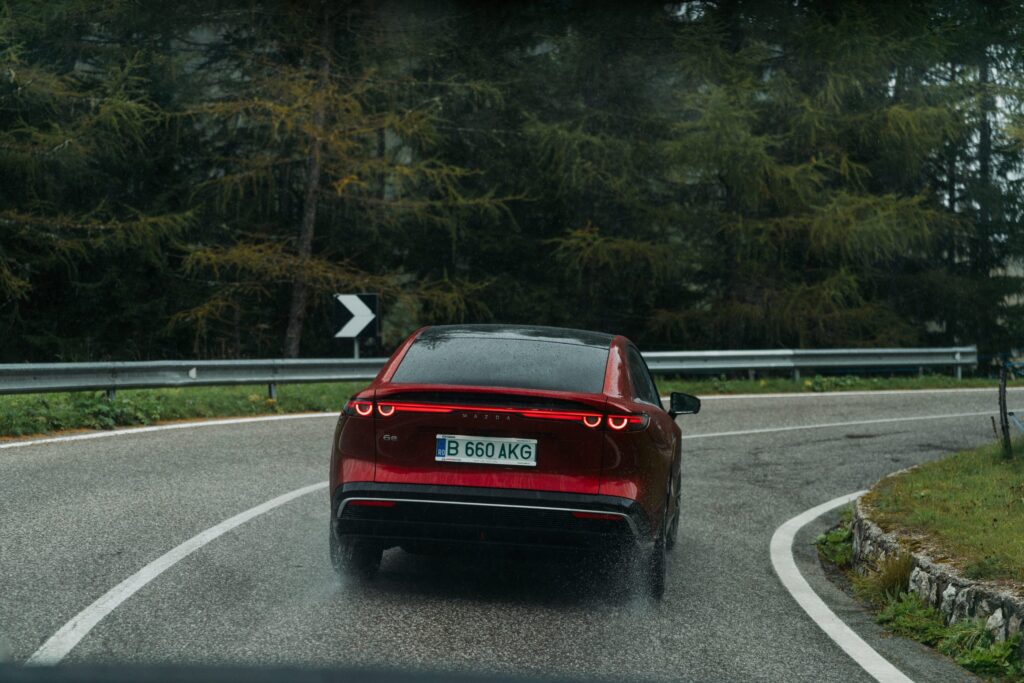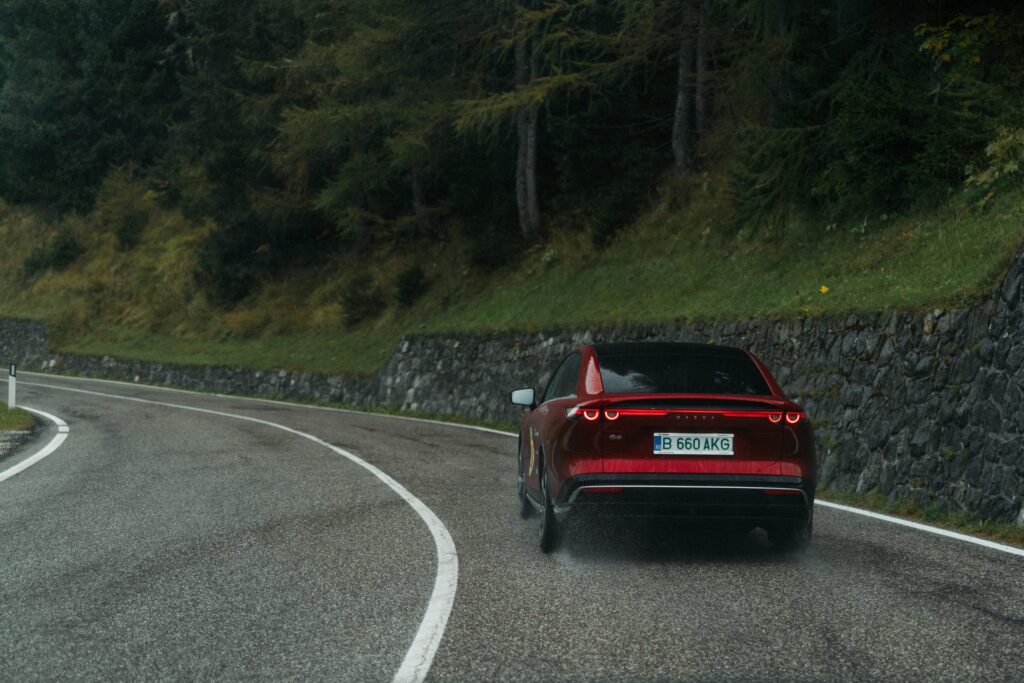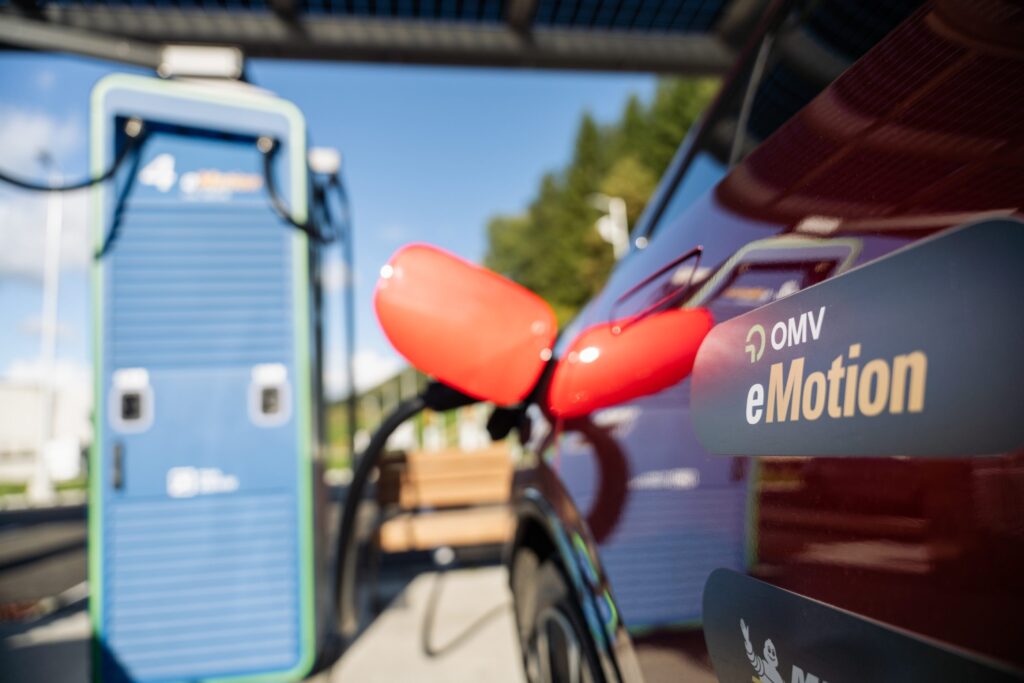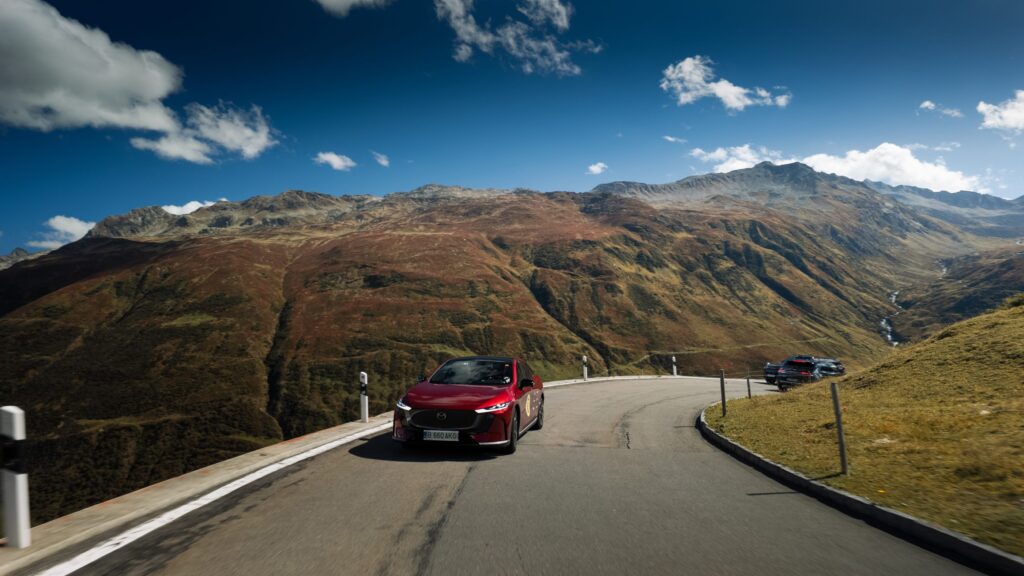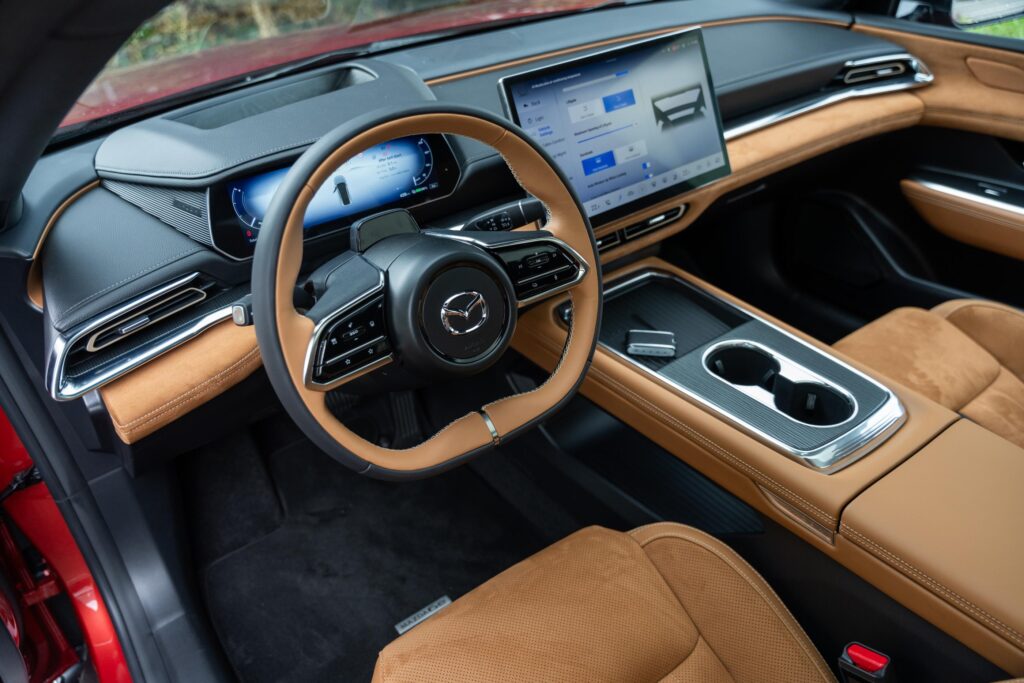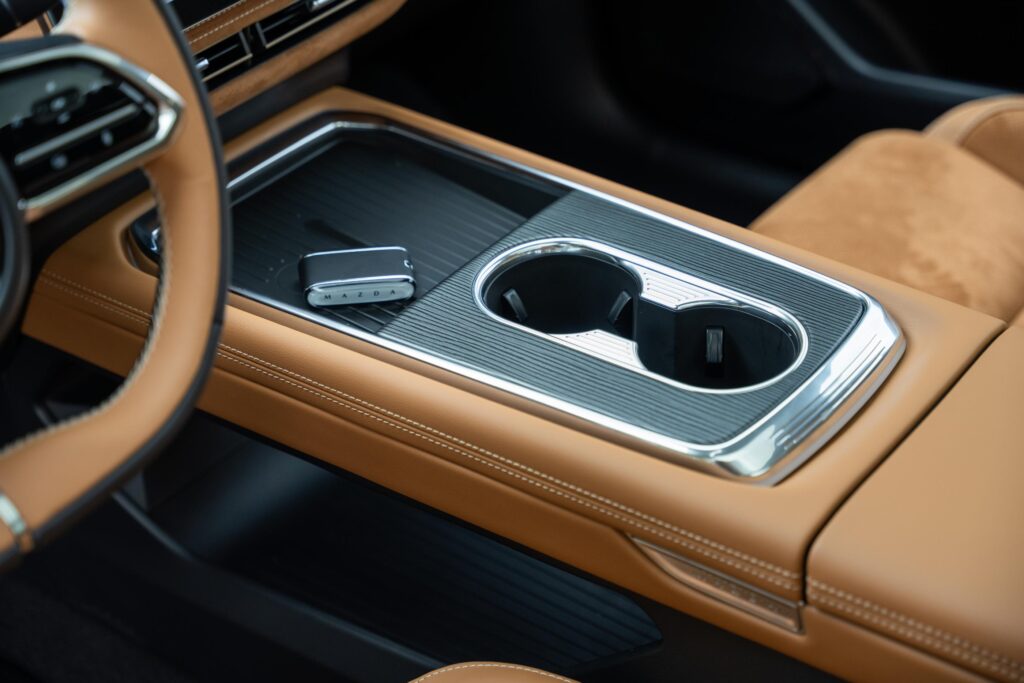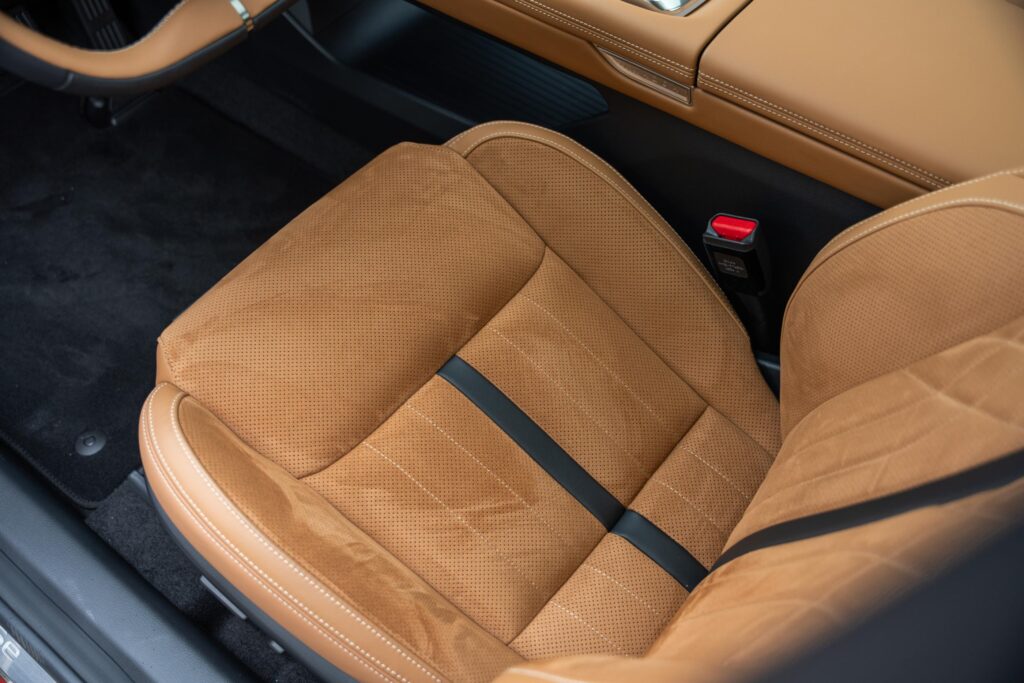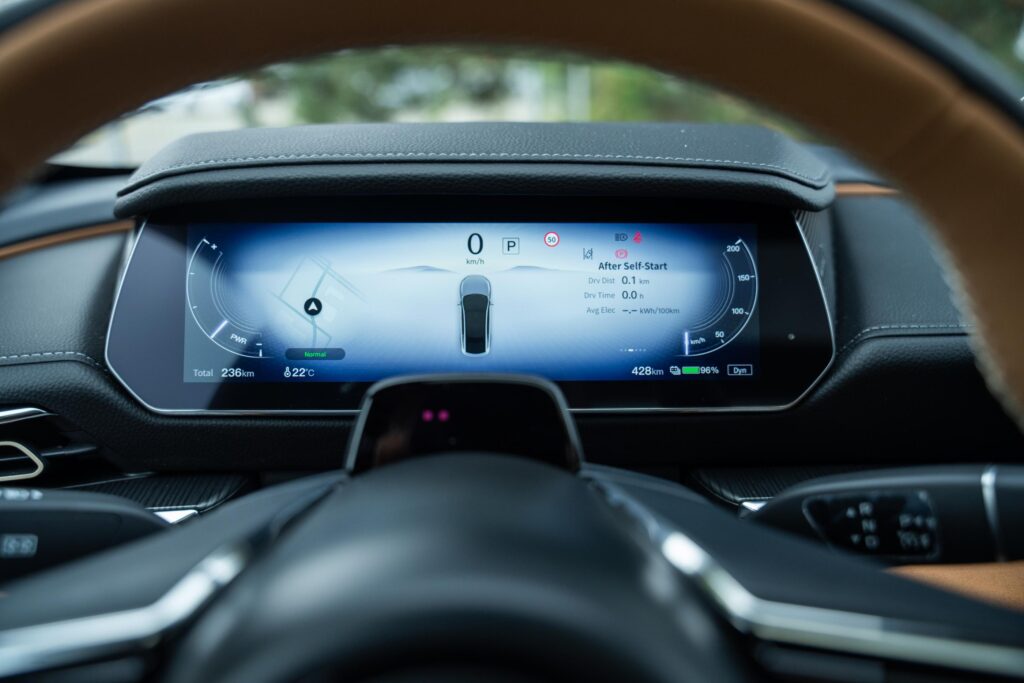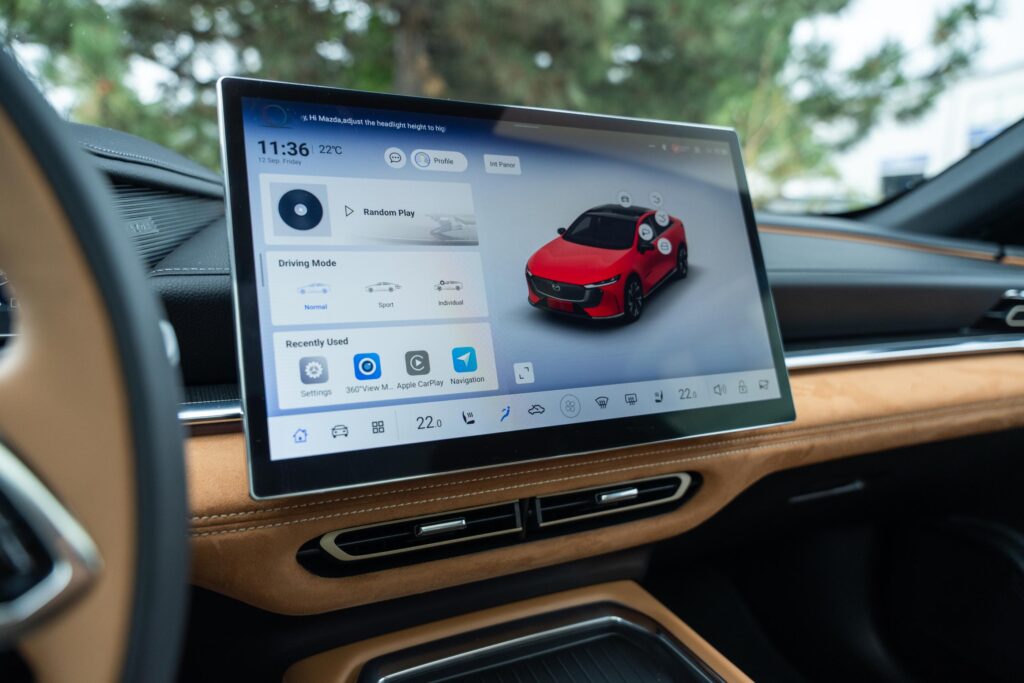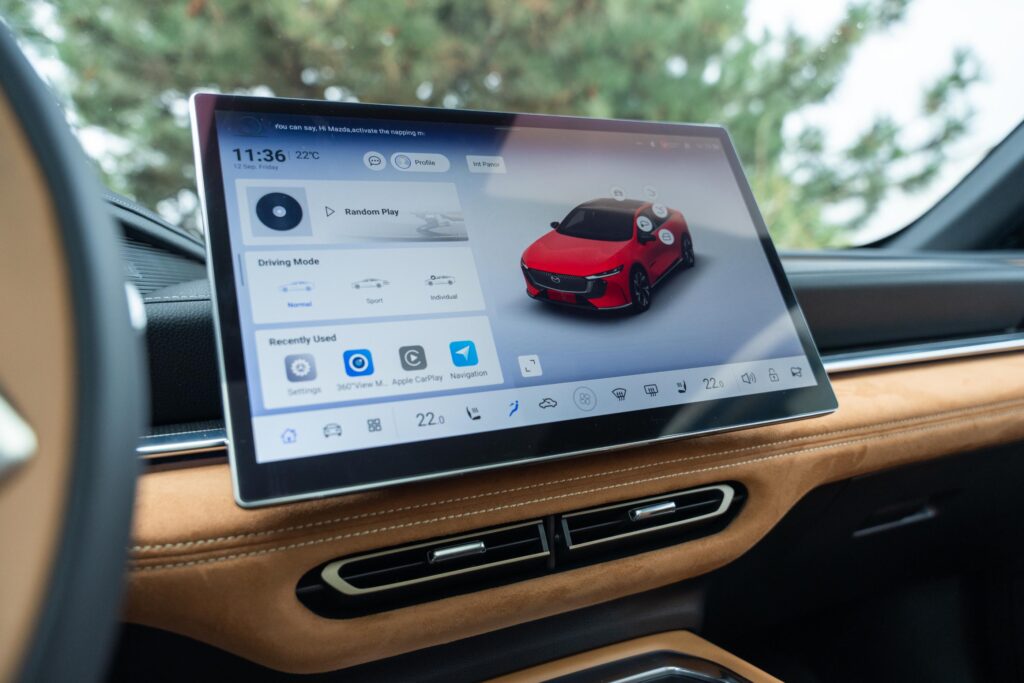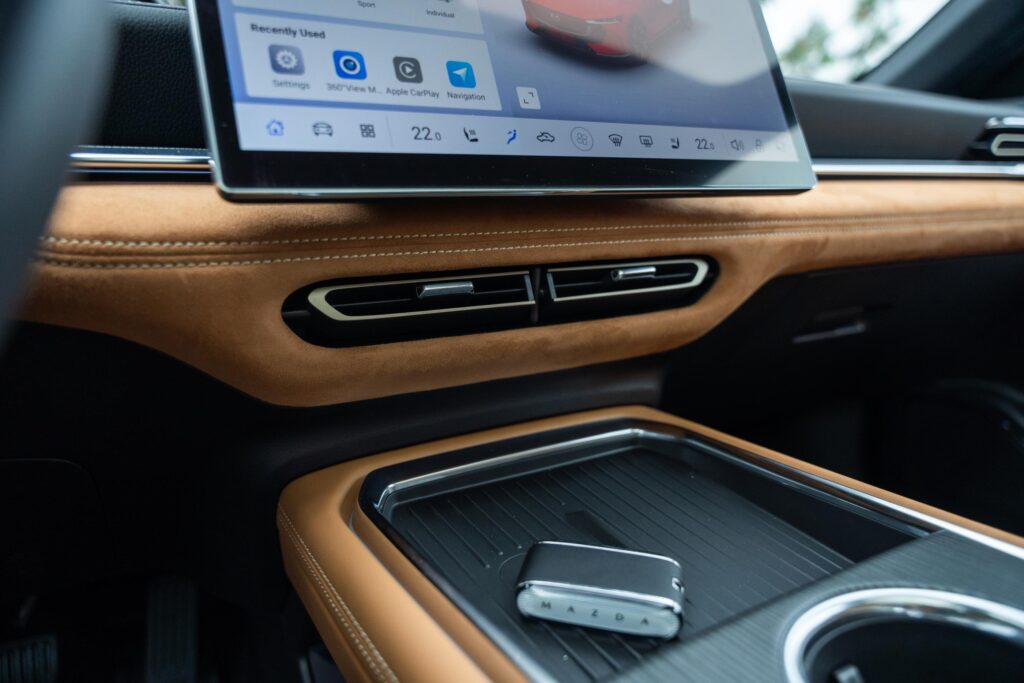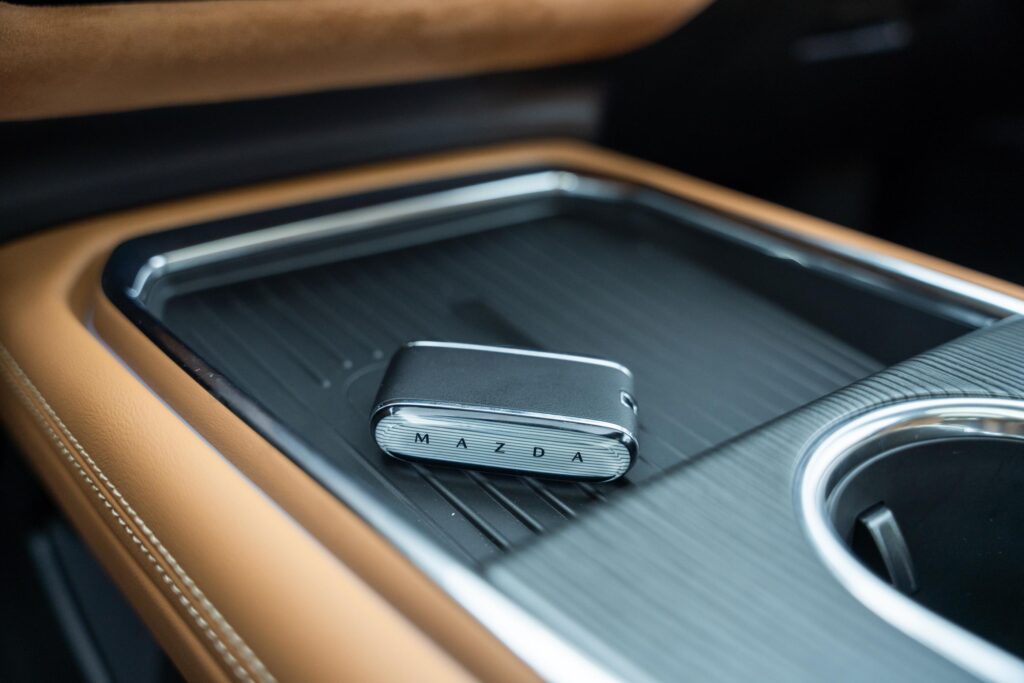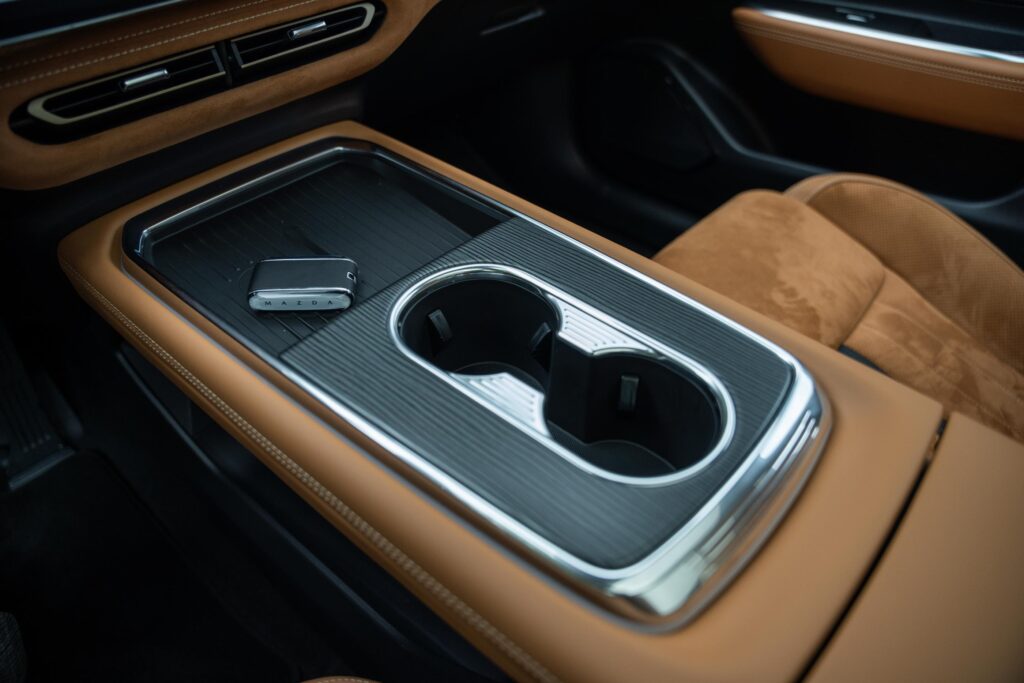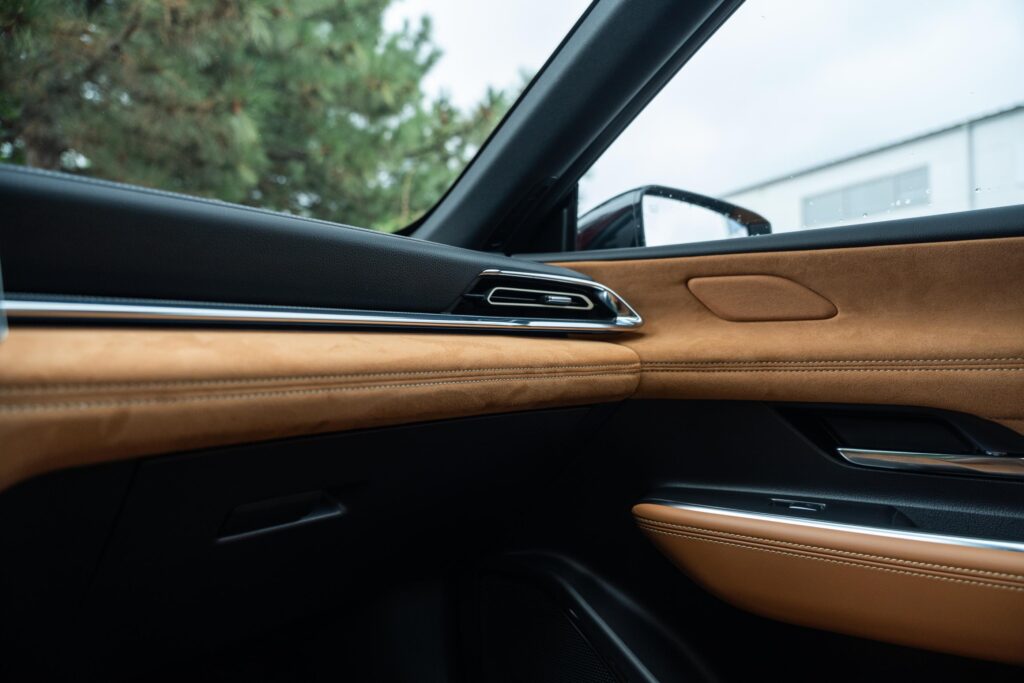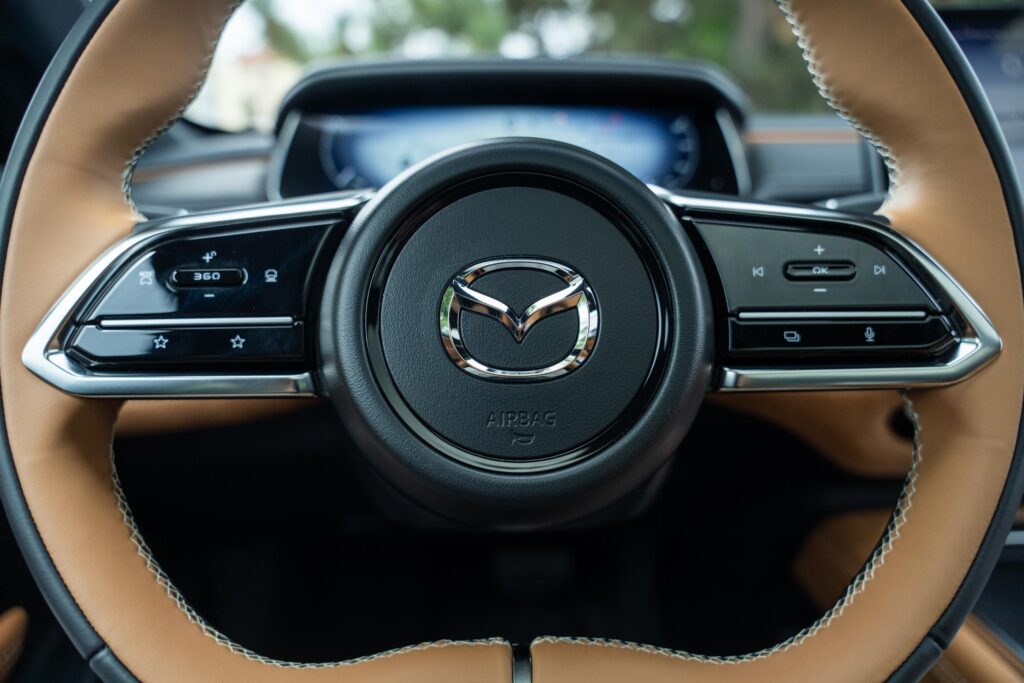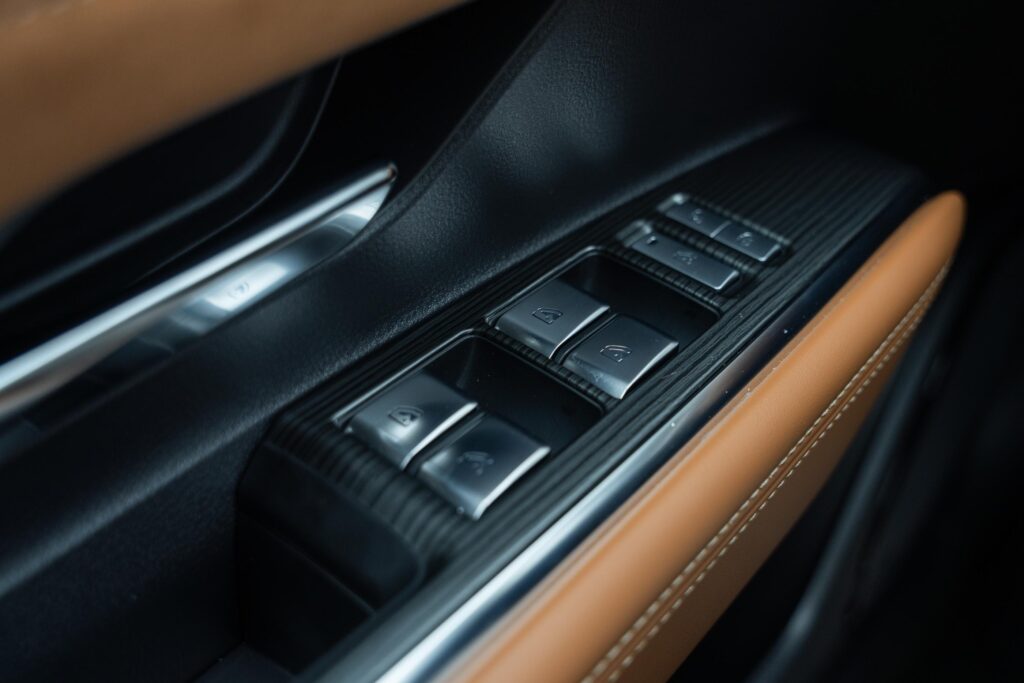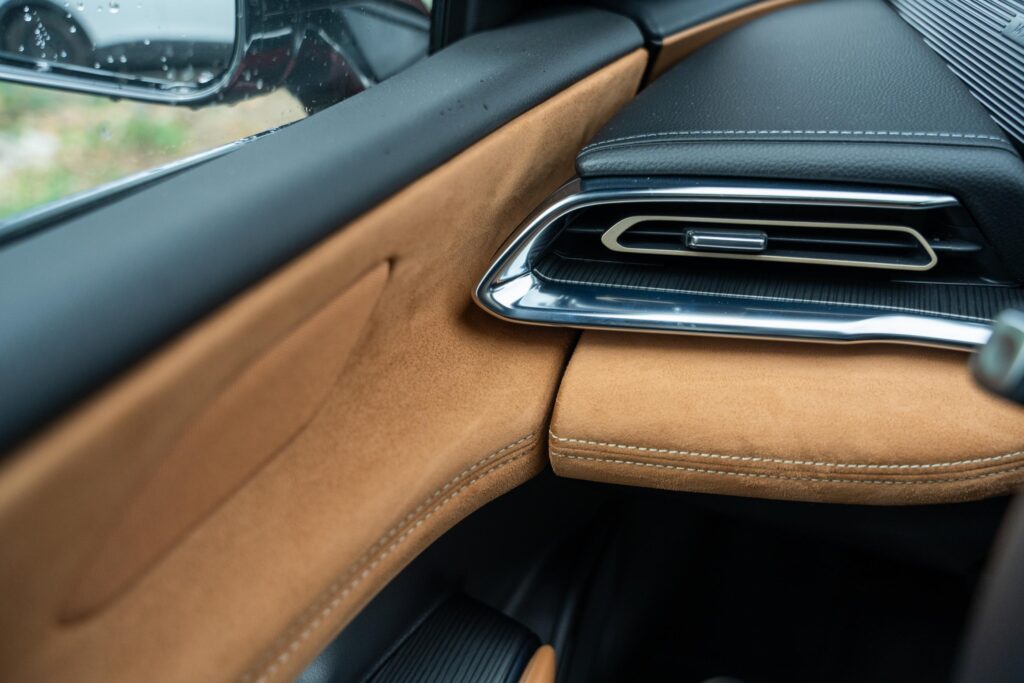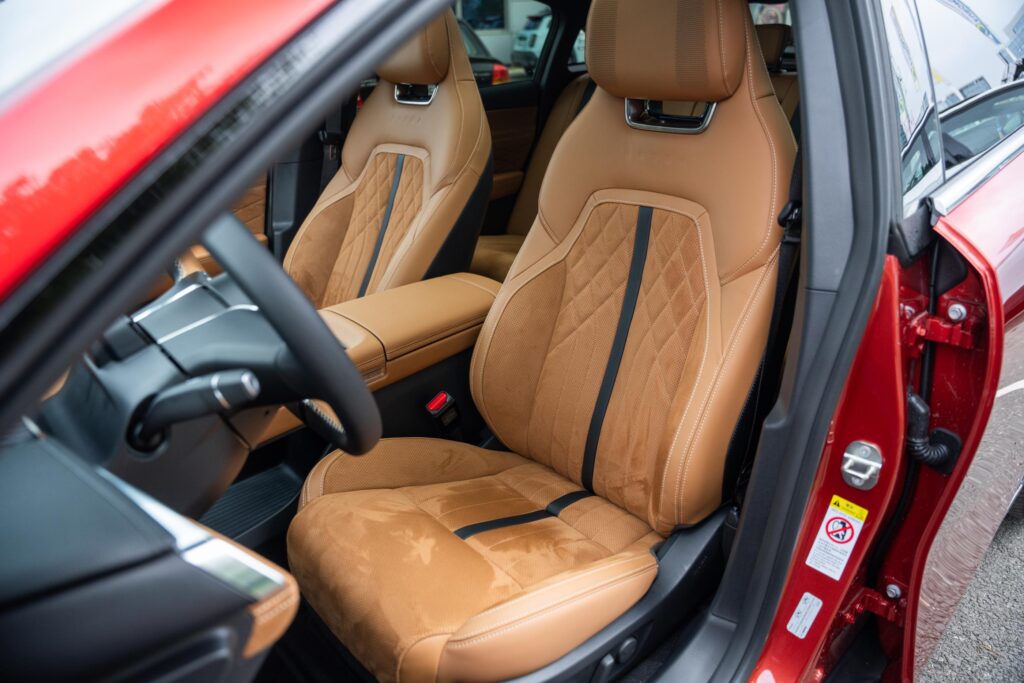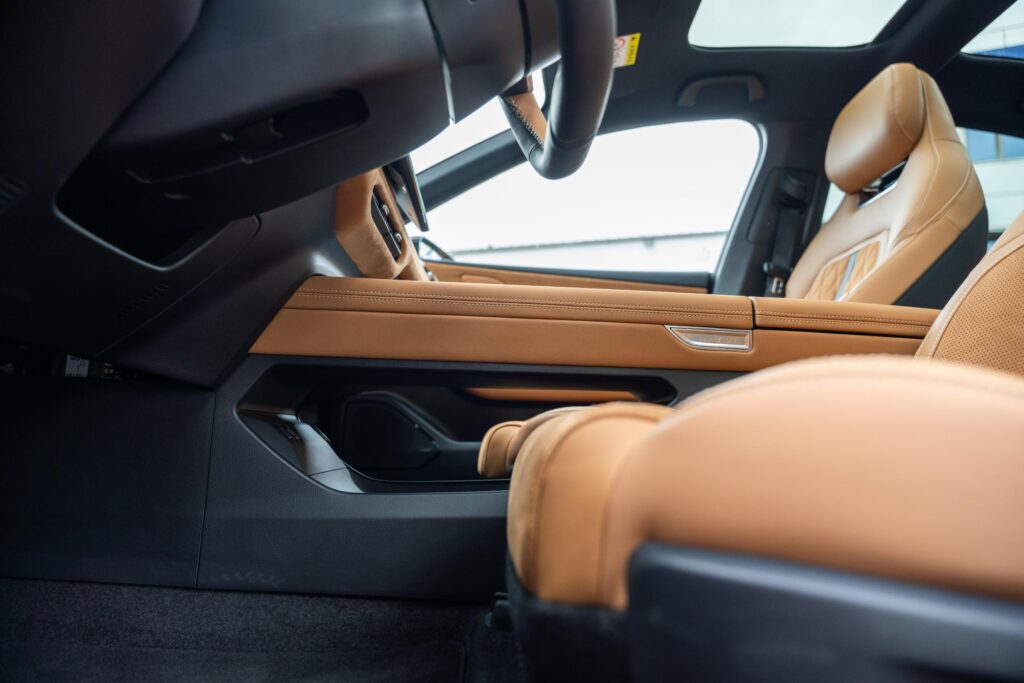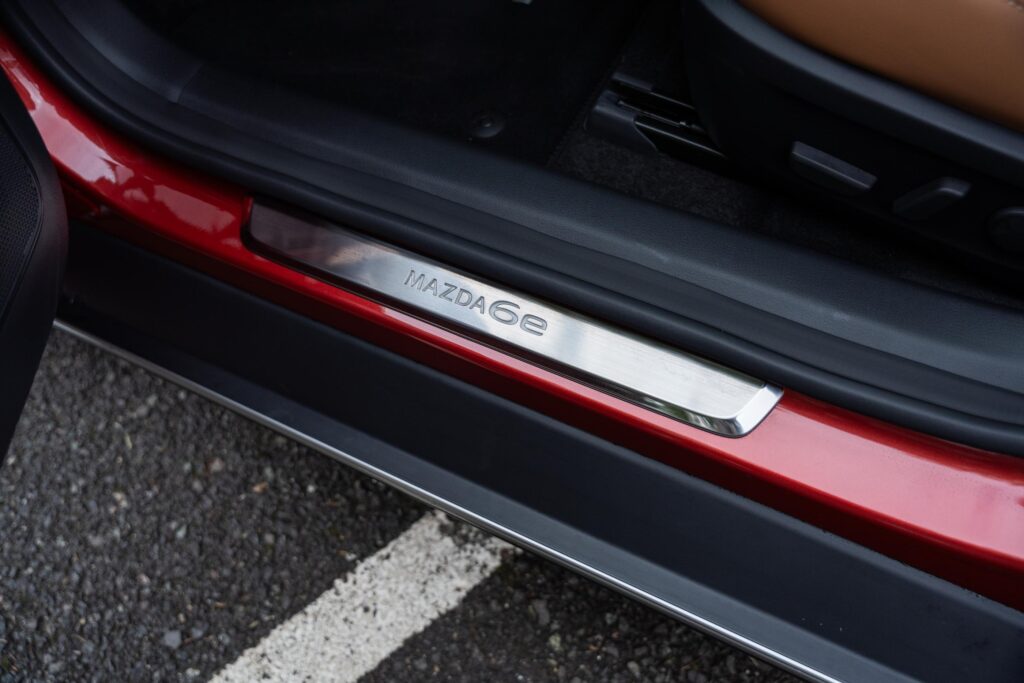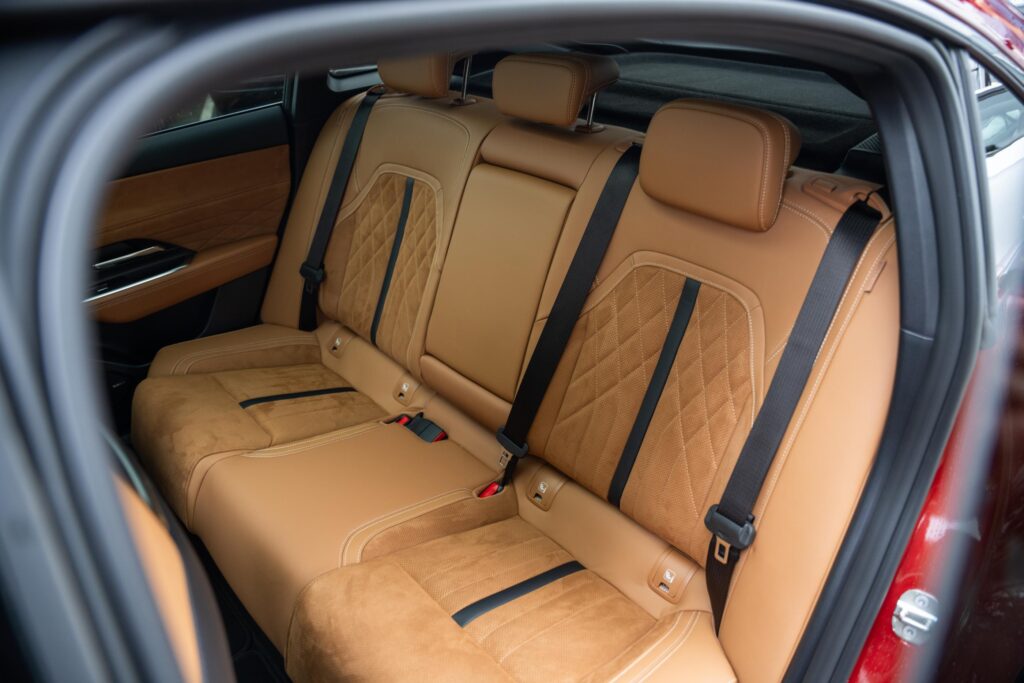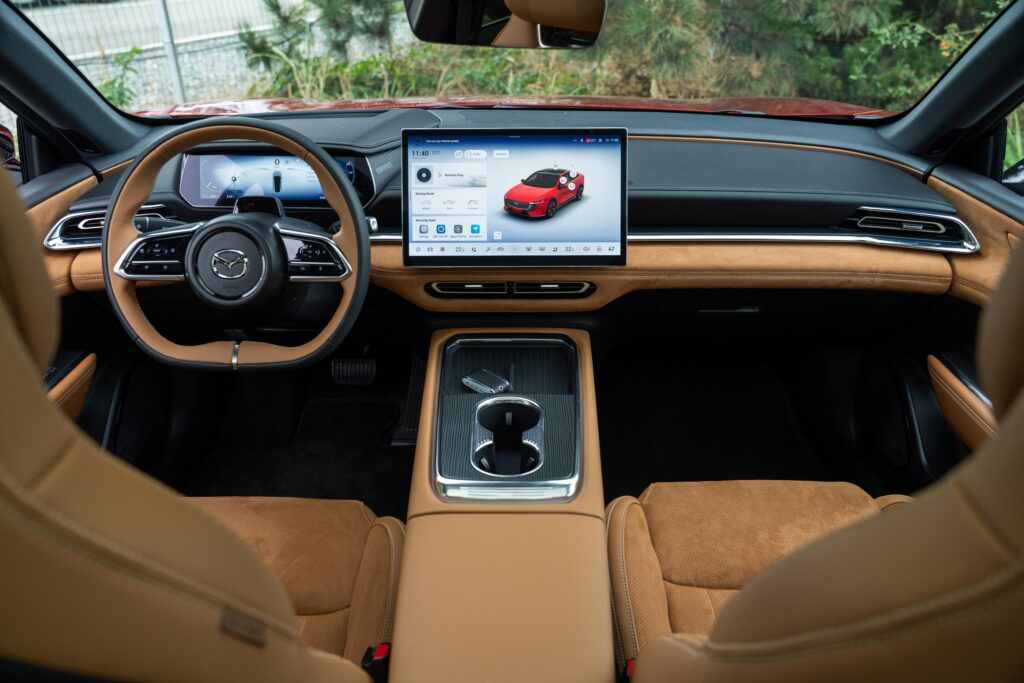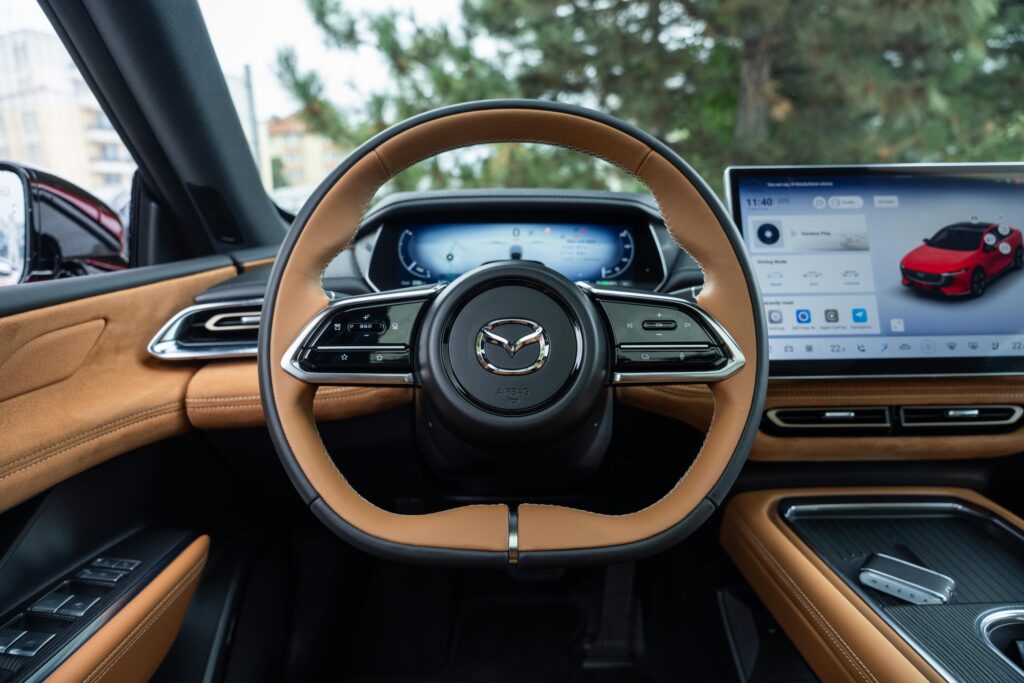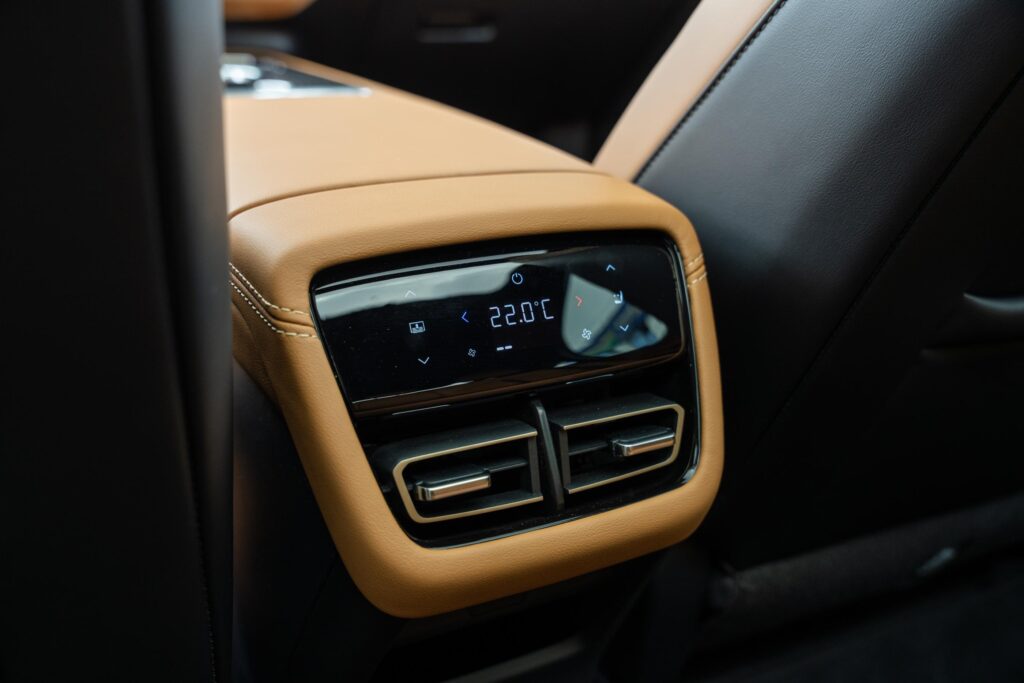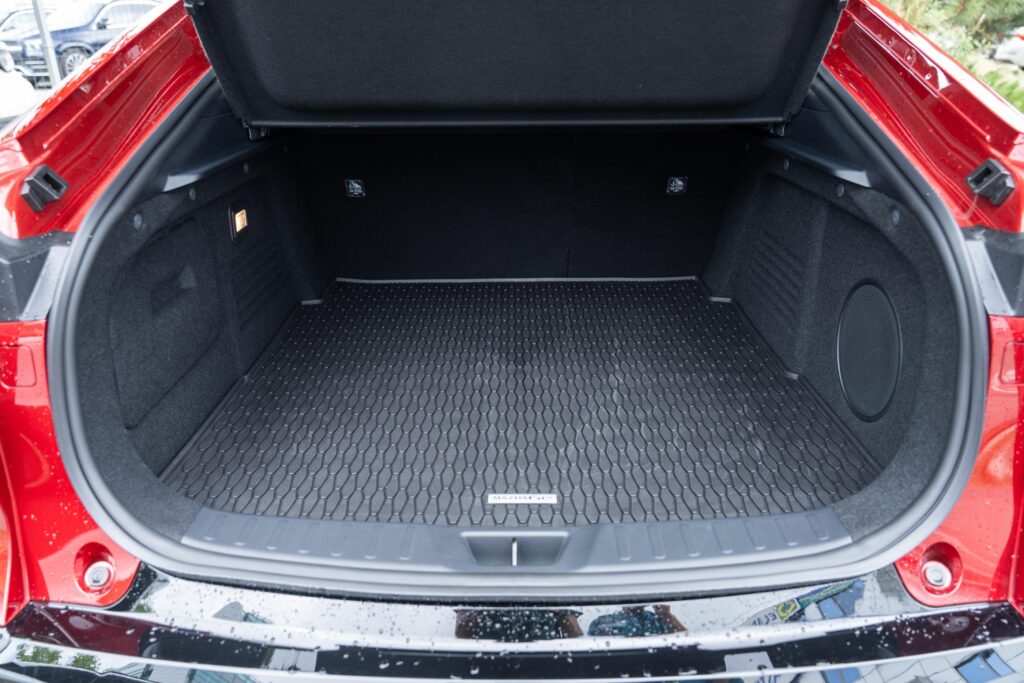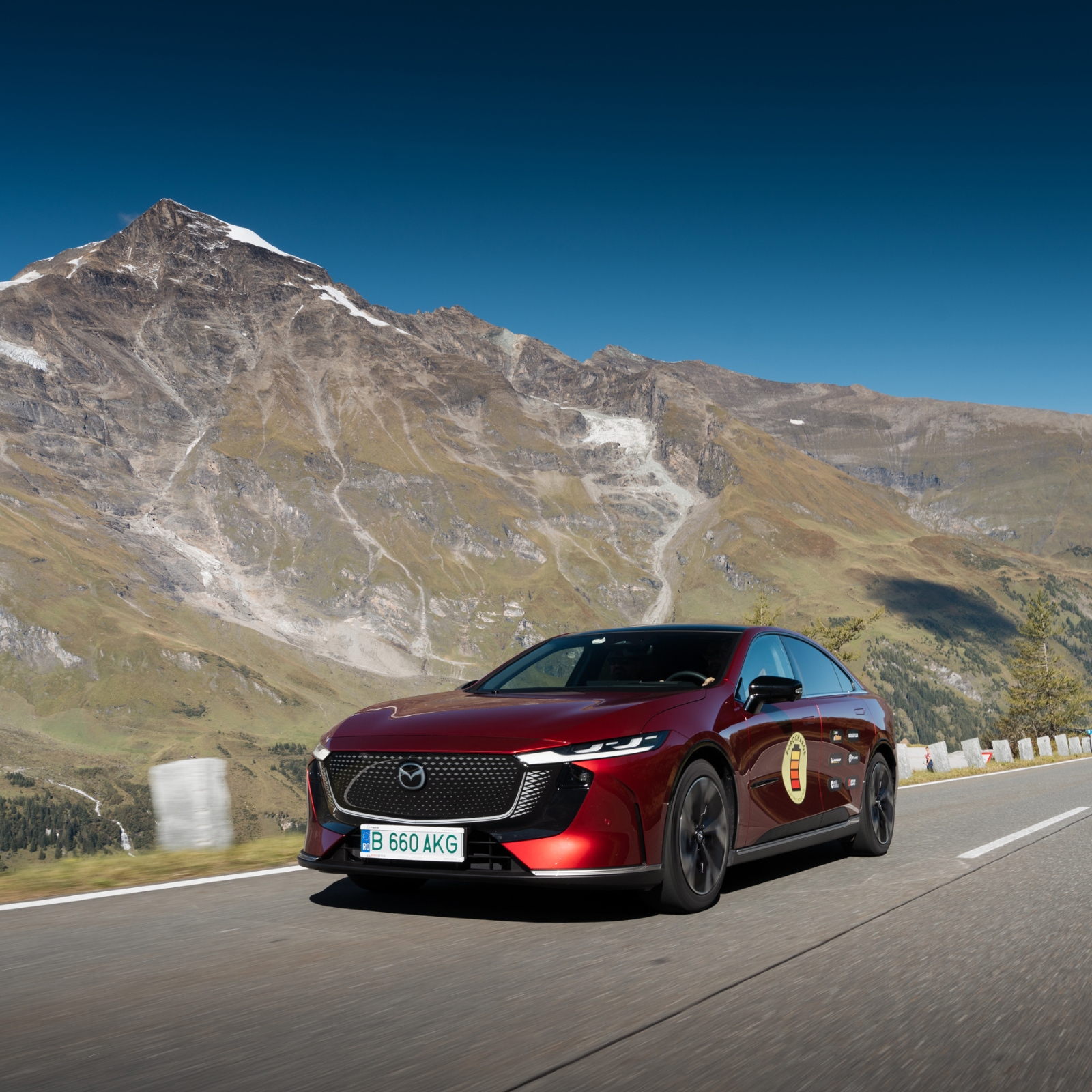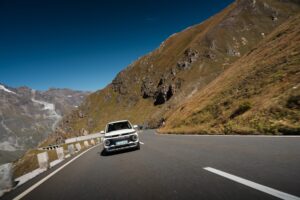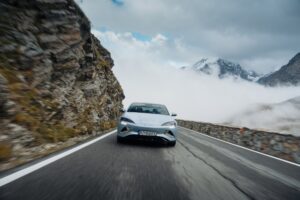The Mazda 6 is an important name for the European client, and now the sedan is moving into full electrification for good. The promises are pretty much the same: comfort, plenty of space and an interior that could always sit at the premium big boys’ table. During Eurocharge by Schaeffler we tested the smaller battery version (68.8 kWh) coupled with the 258 hp motor. As a footnote: the second version offers an 80 kWh battery and slightly less power: 245 hp. Whichever option you choose, power is sent to the rear axle.
Beyond the design – one of the elements that got the most attention – the Mazda 6e didn’t break the brand’s golden rule: Jinba Ittai – the communion between horse and rider, the way the Japanese manufacturer has managed for years to put cars on the market that communicate properly with the one behind the wheel.
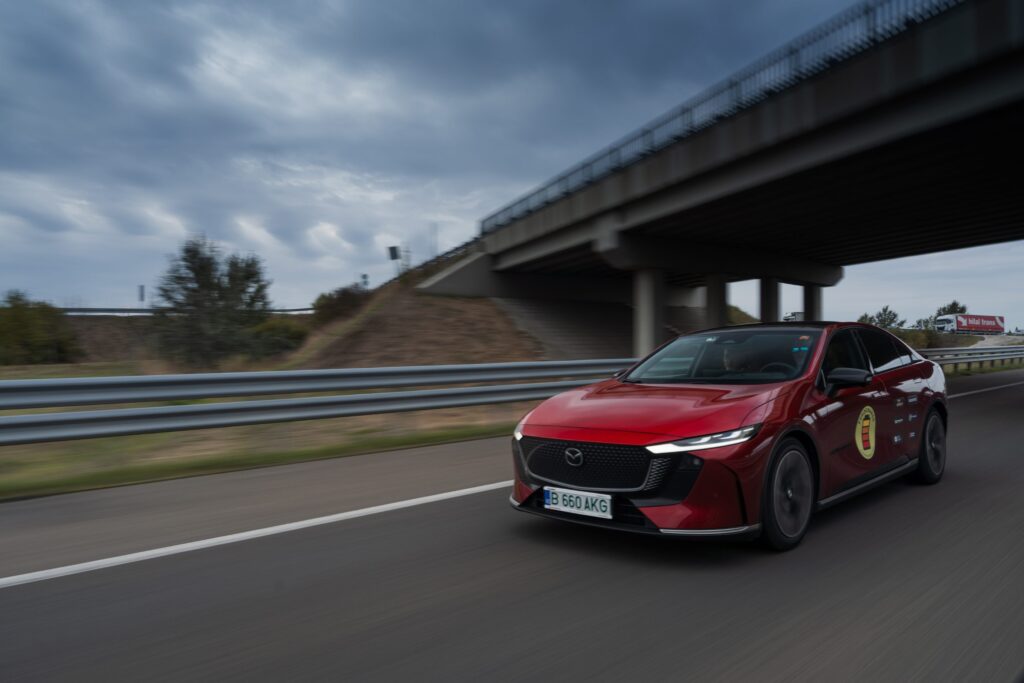
Below we have prepared all the information on range and consumption recorded in real traffic, charging time spent at stations and energy costs. We’ve put them infographics that are easy to follow and understand, and at the end we’ve also drawn some conclusions based on the figures.
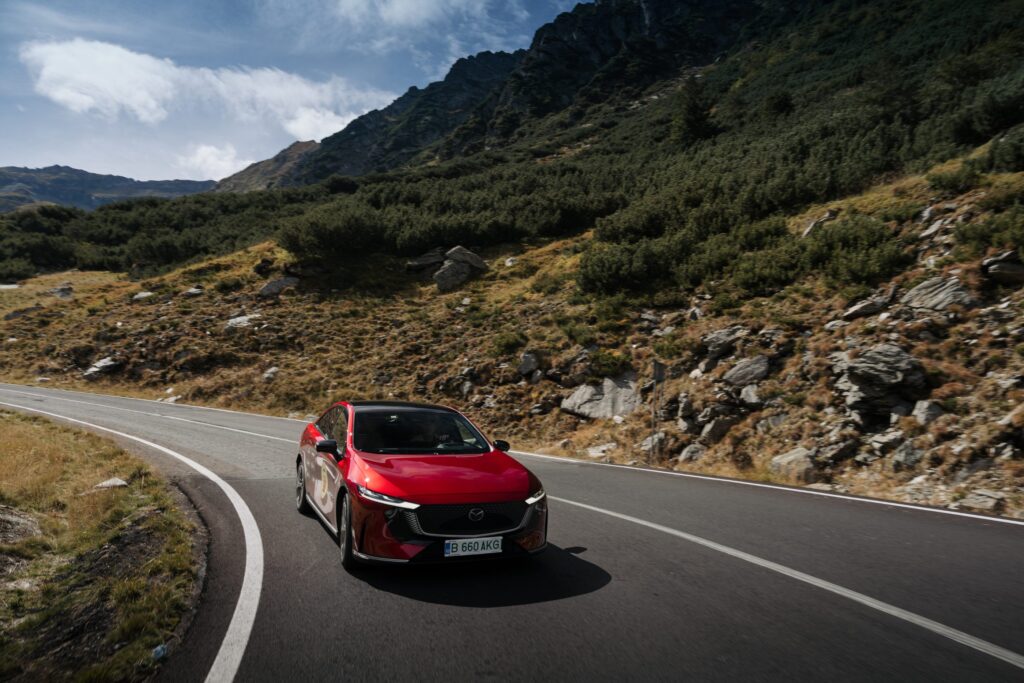
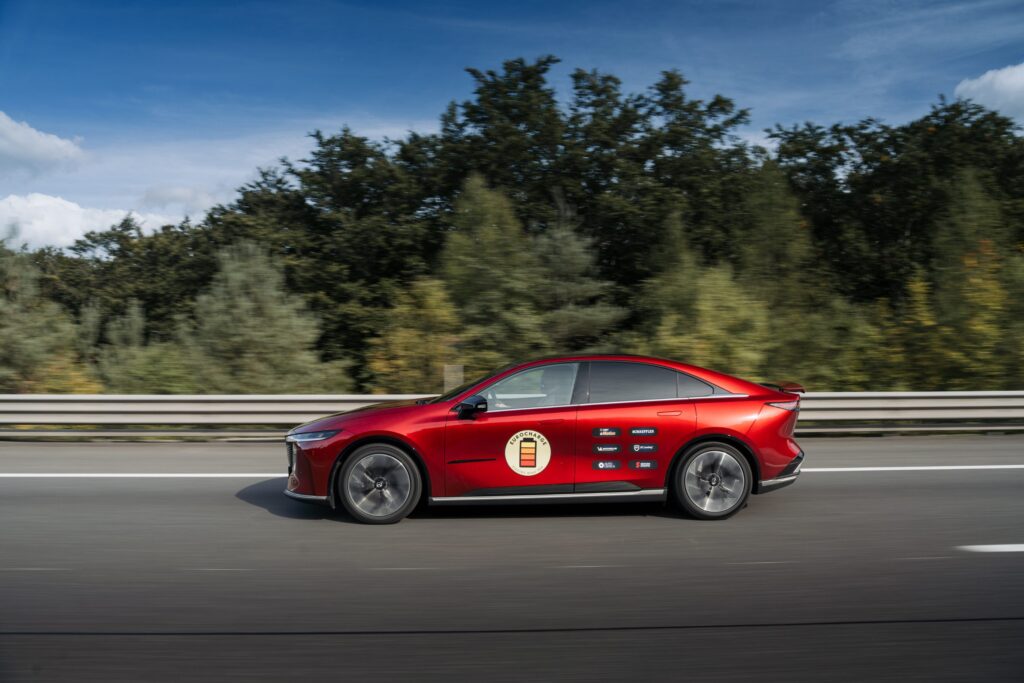
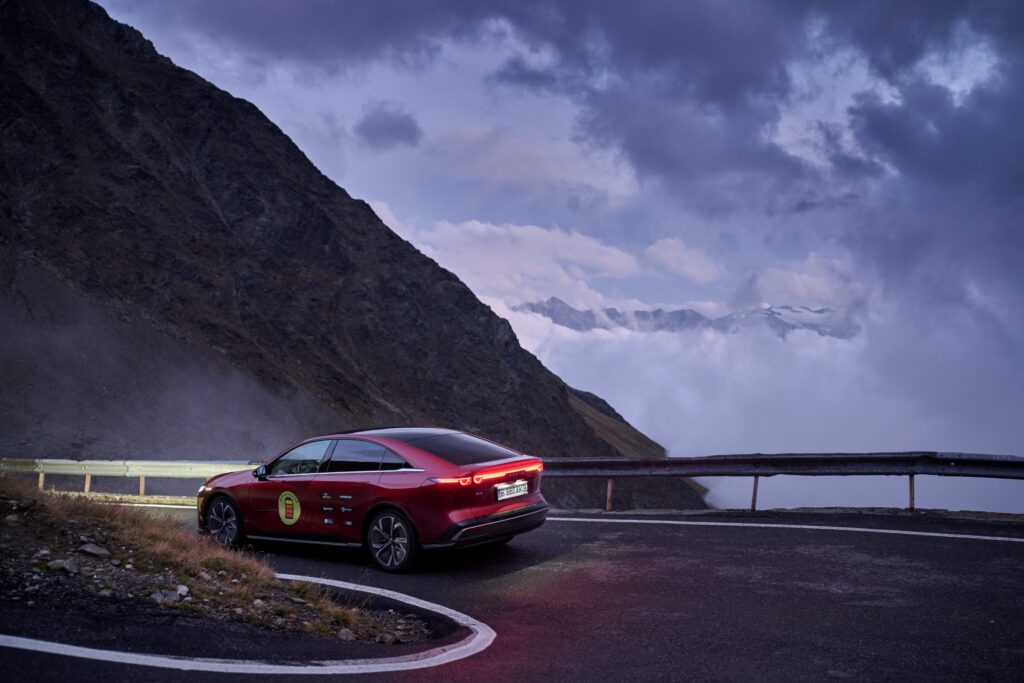
Mazda 6e: daily infographics on consumption, real range, charging costs
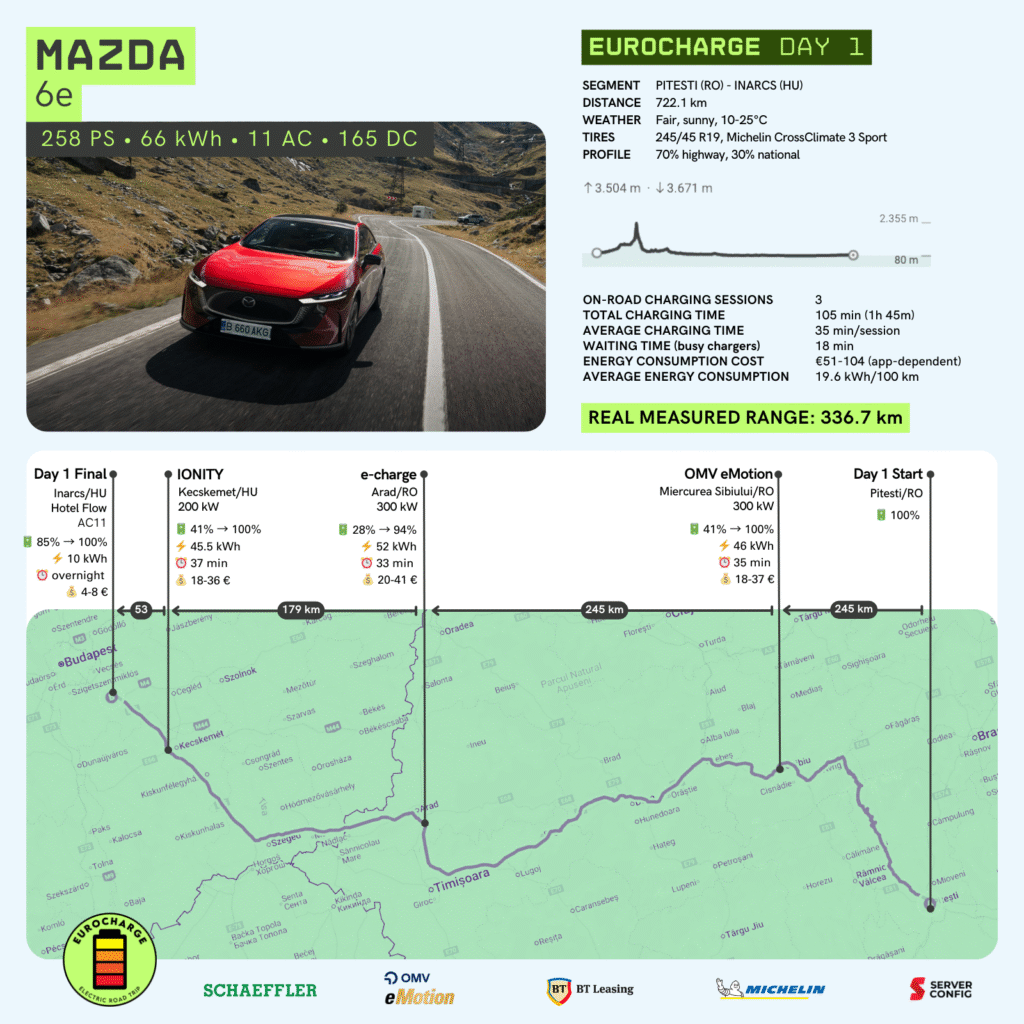
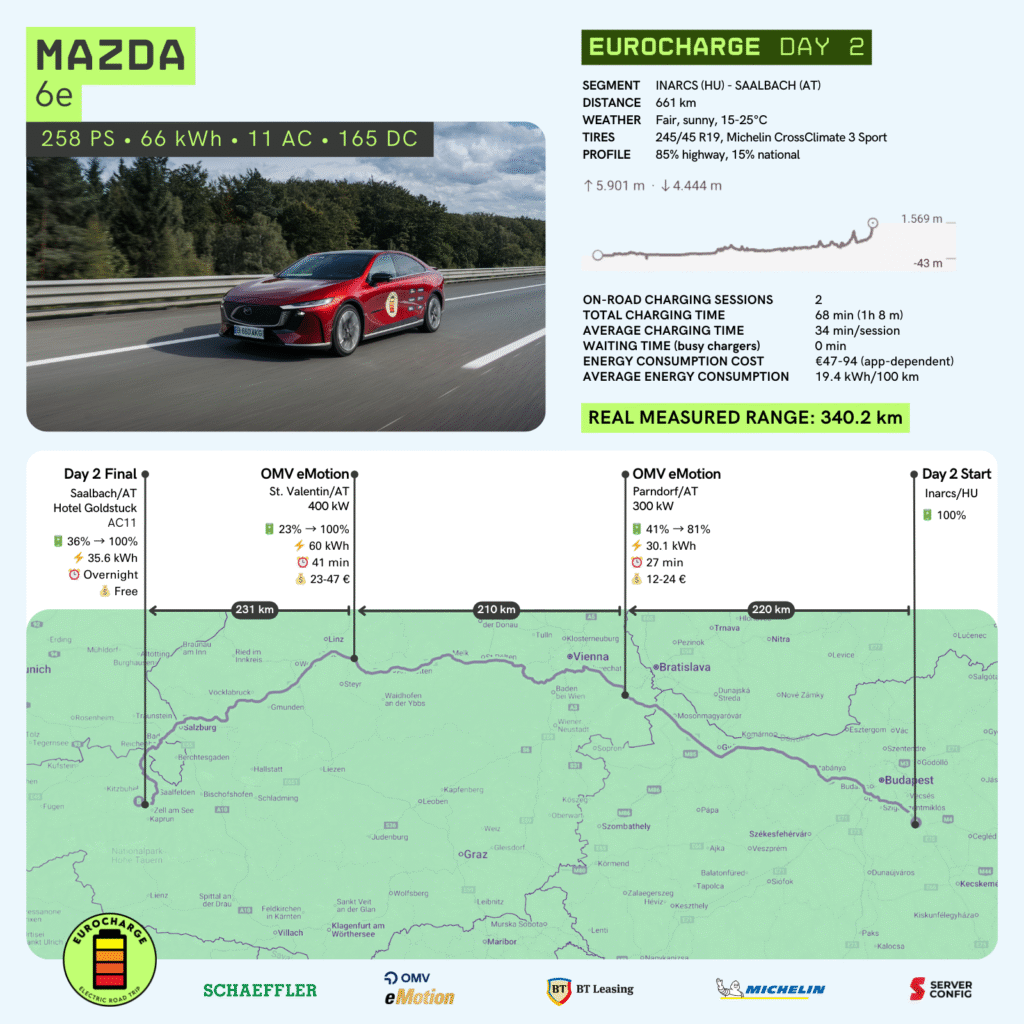
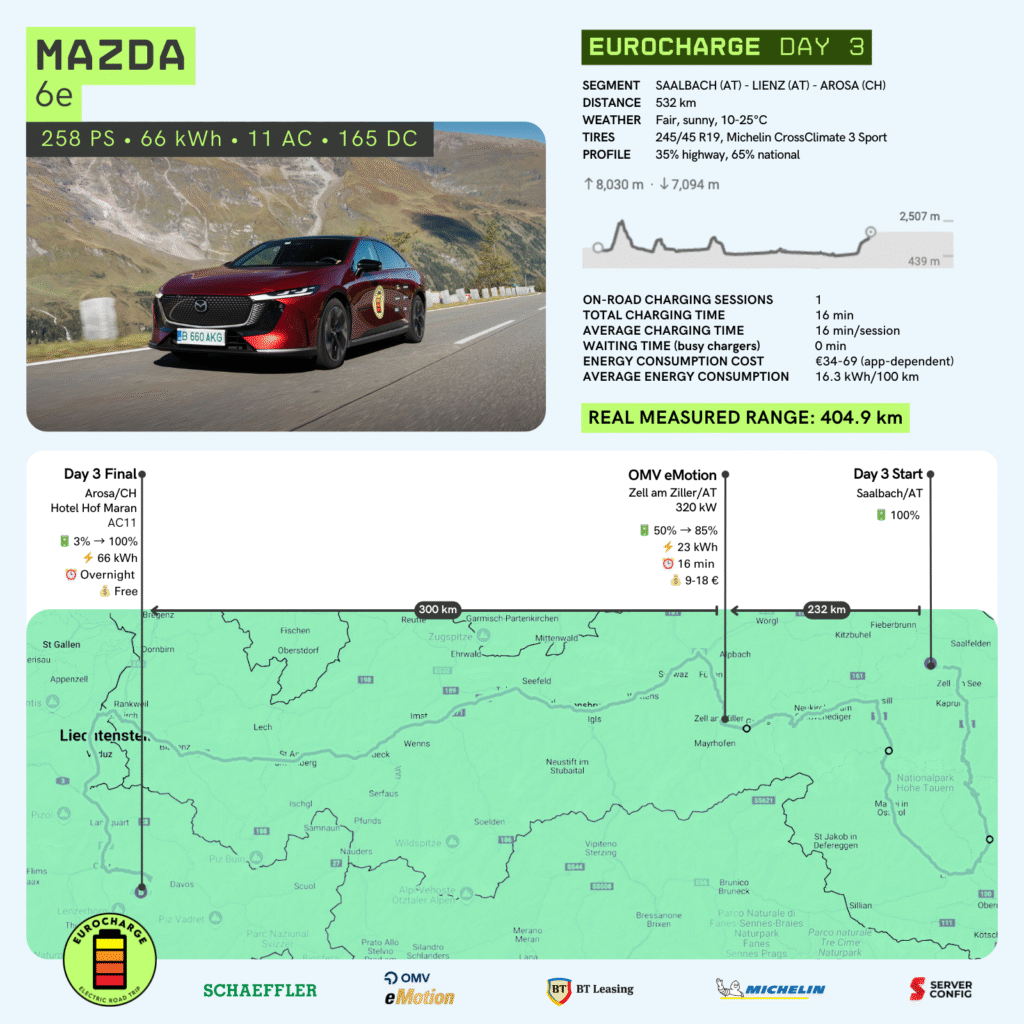
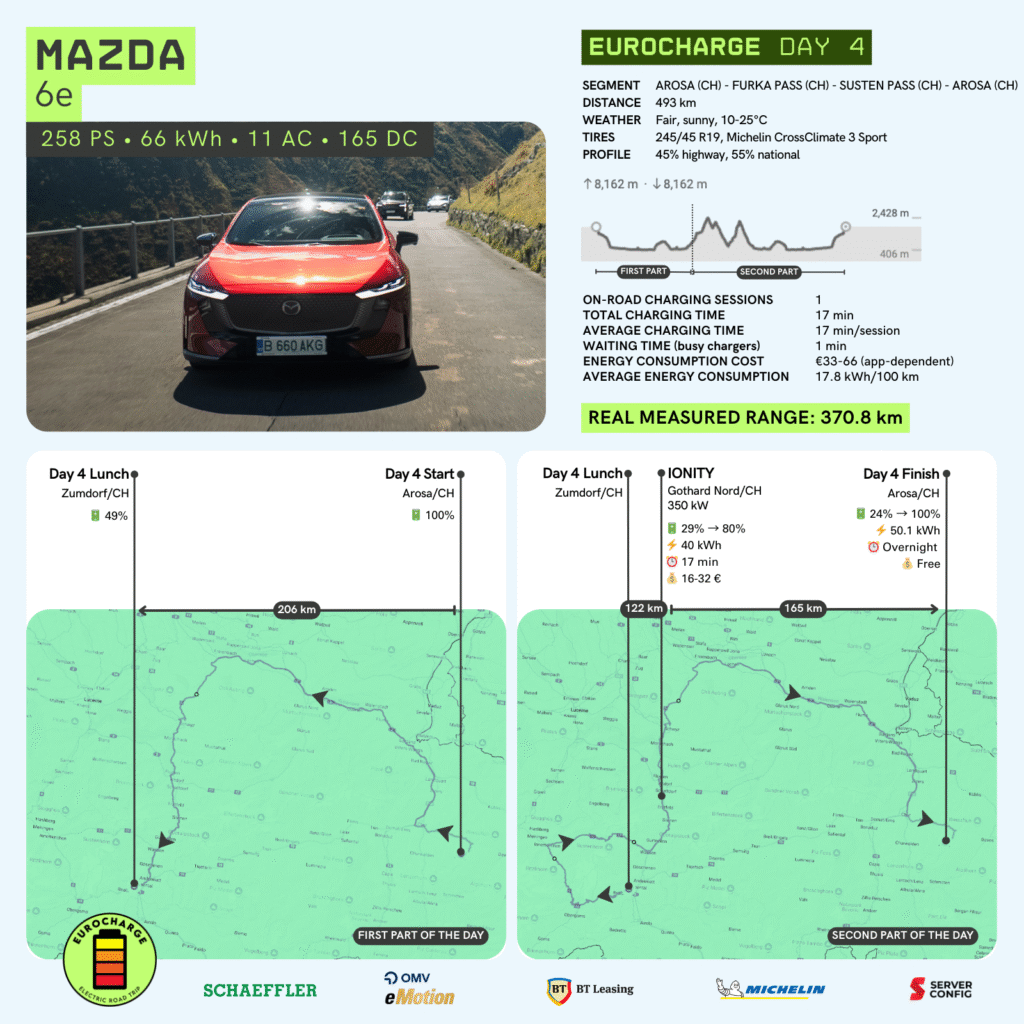
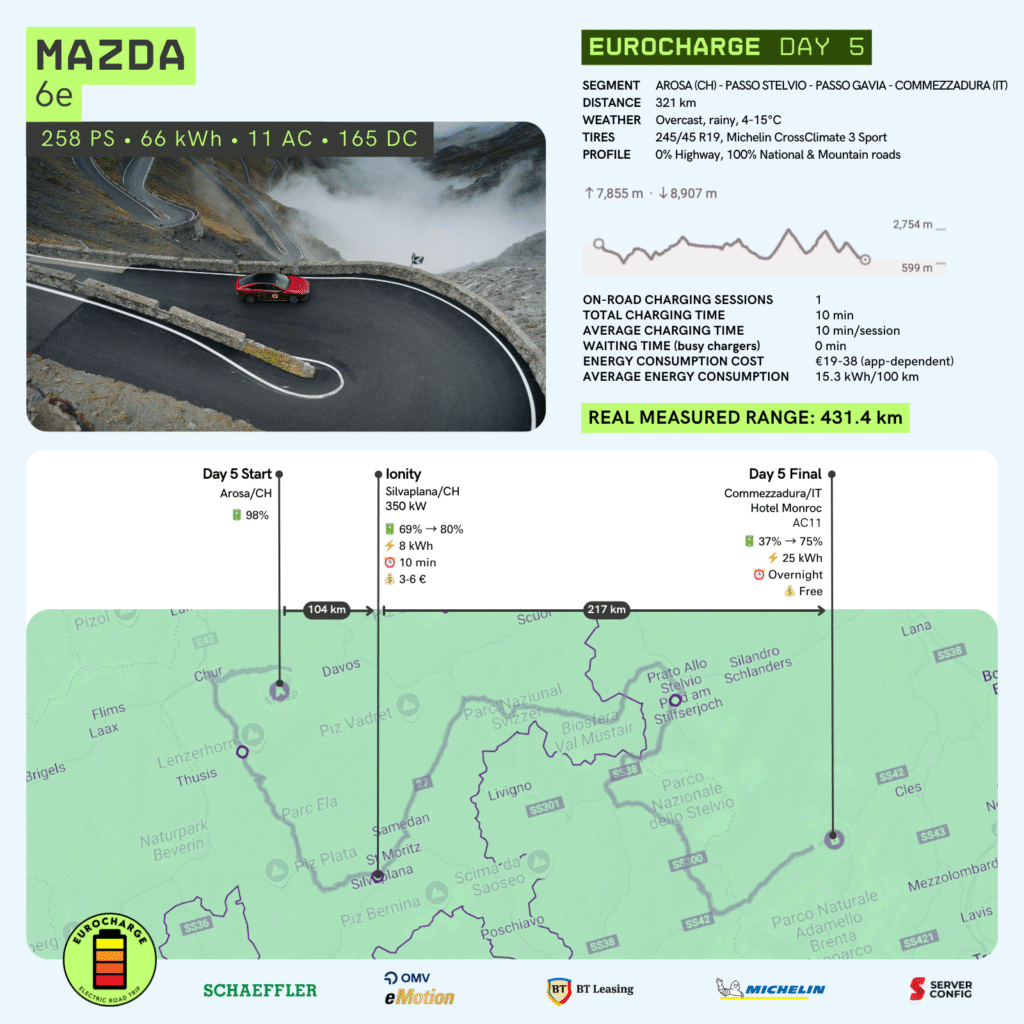
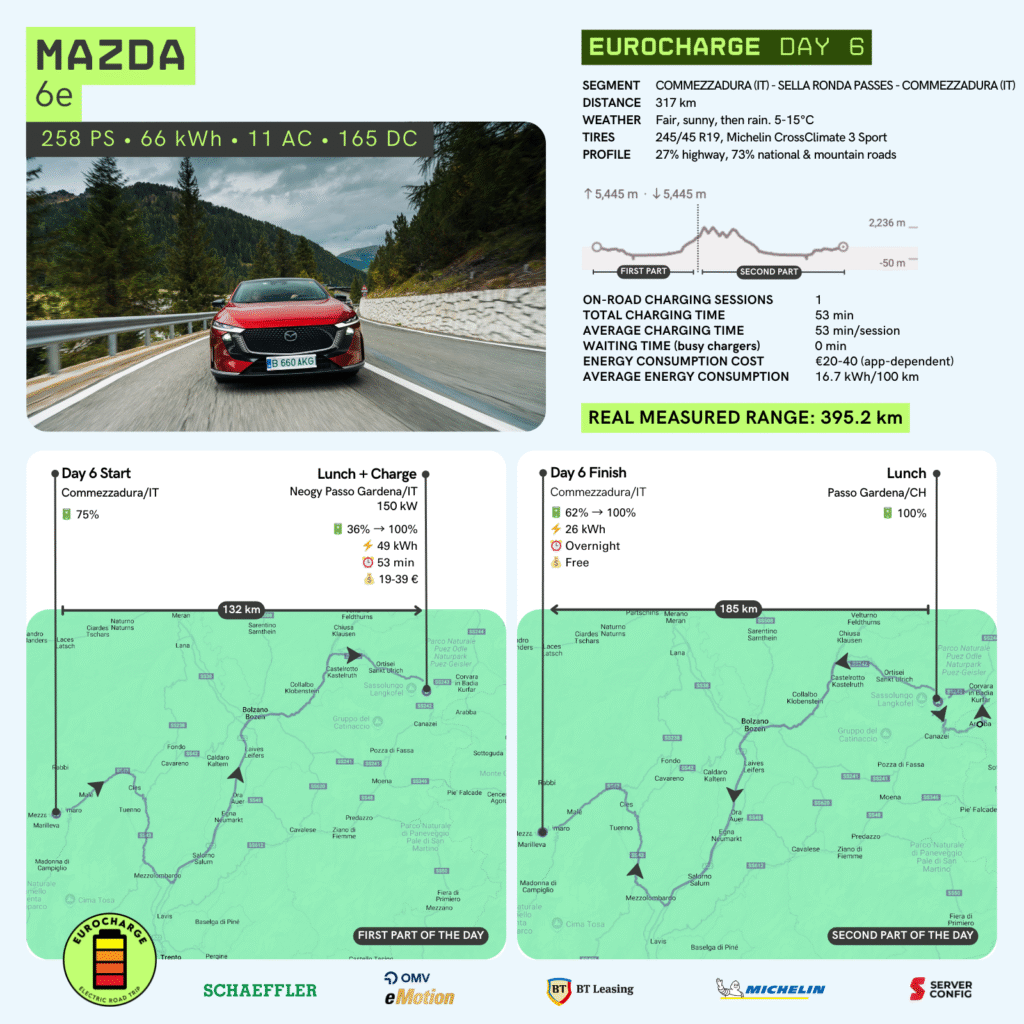
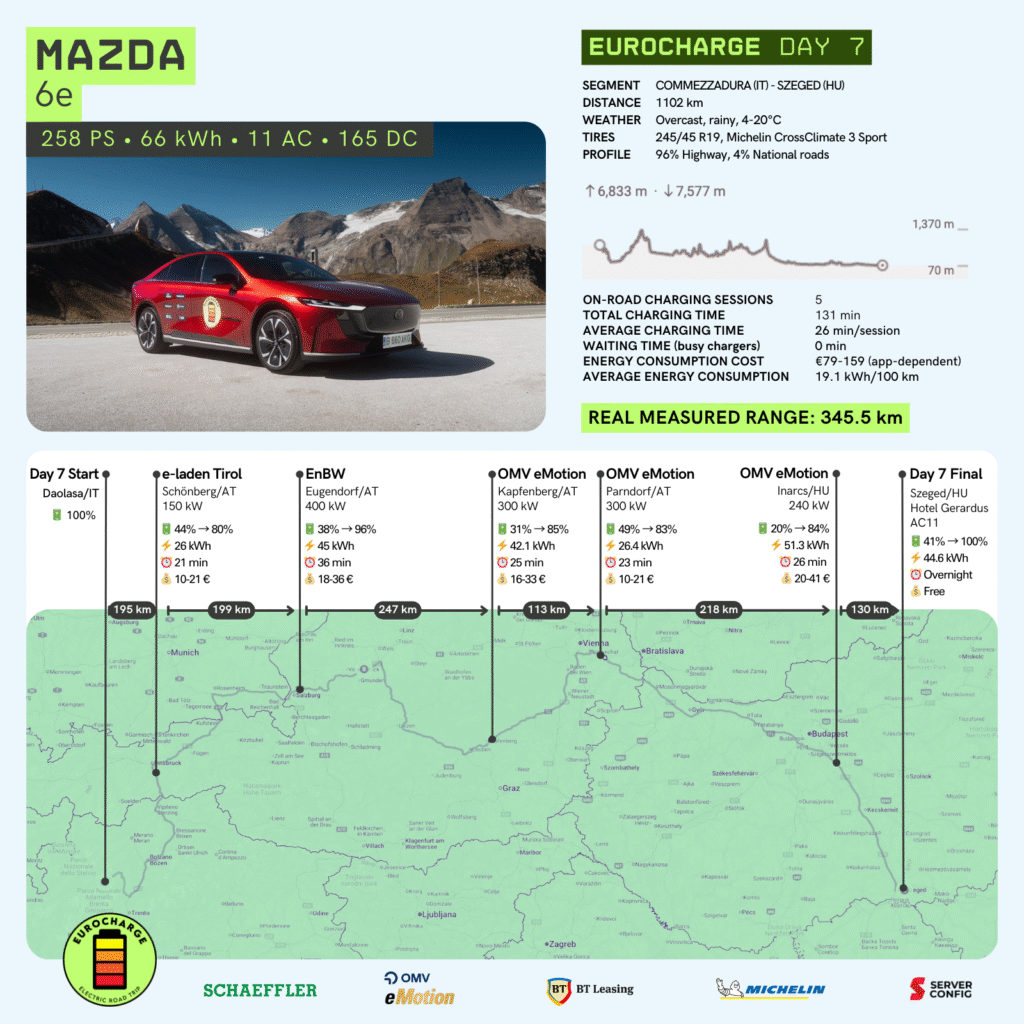
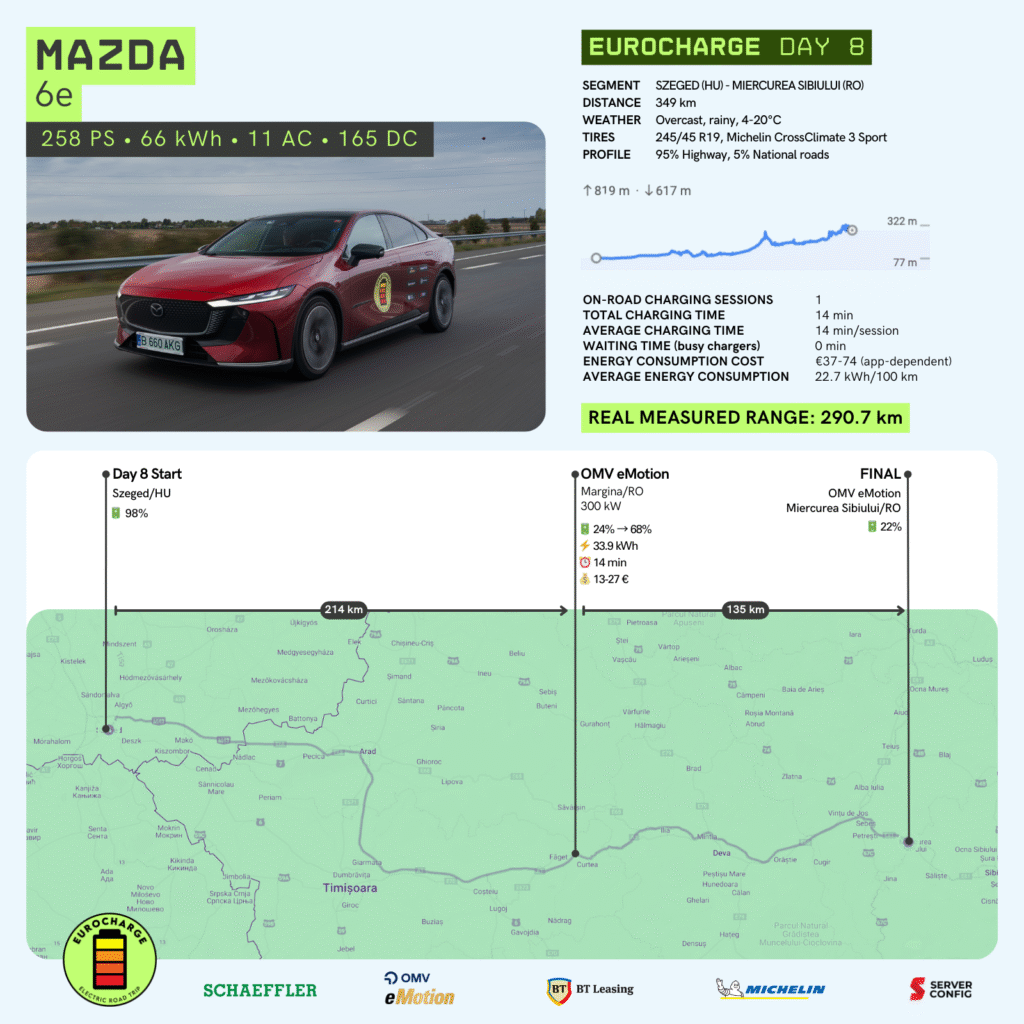
Mazda 6e by the numbers:
- Total distance traveled: 4497 km
- Total number of charging stops: 15 sessions on the road + 7 overnight charges
- Total time spent while charging on the road: 6 hours 54 minutes (414 minutes)
- Total energy charged: 835.6 kWh, of which 257.3 kWh in hotels
- Total cost of charges (hotel charges were free): between €225.5 and €456.9 (depending on the app used)
- Fuel cost comparison (estimated per route):
- Petrol: ~688 Euro
- Diesel: ~526 Euro
- Weighted average of the energy consumption over the whole route: 18.6 kWh/100 km
- Weighted real average range: 358.5 km
Important mention on the driving style: Throughout the entire test, the car was driven in “Normal” mode, never “Eco”. It drove steadily, within the speed limits, with an approach as close as possible to the legal speed limit on each road segment.
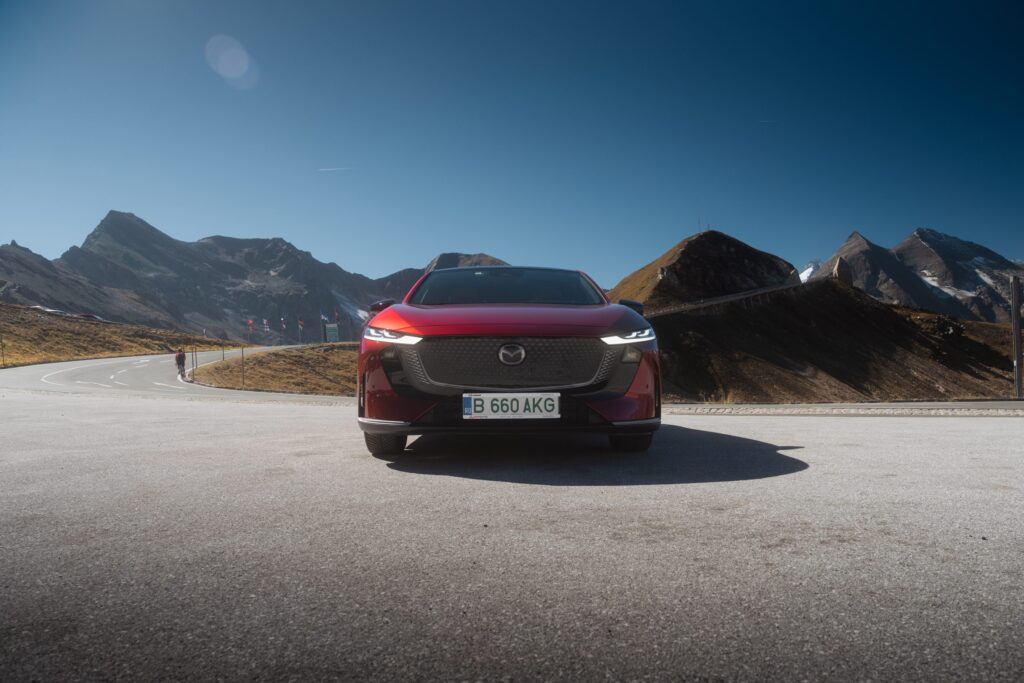
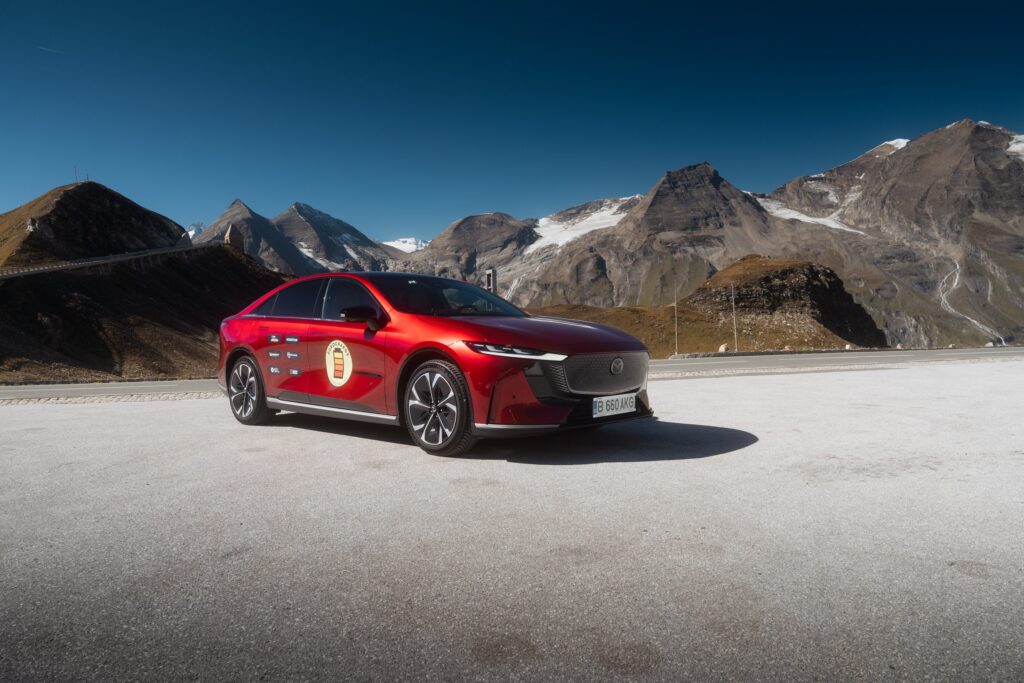
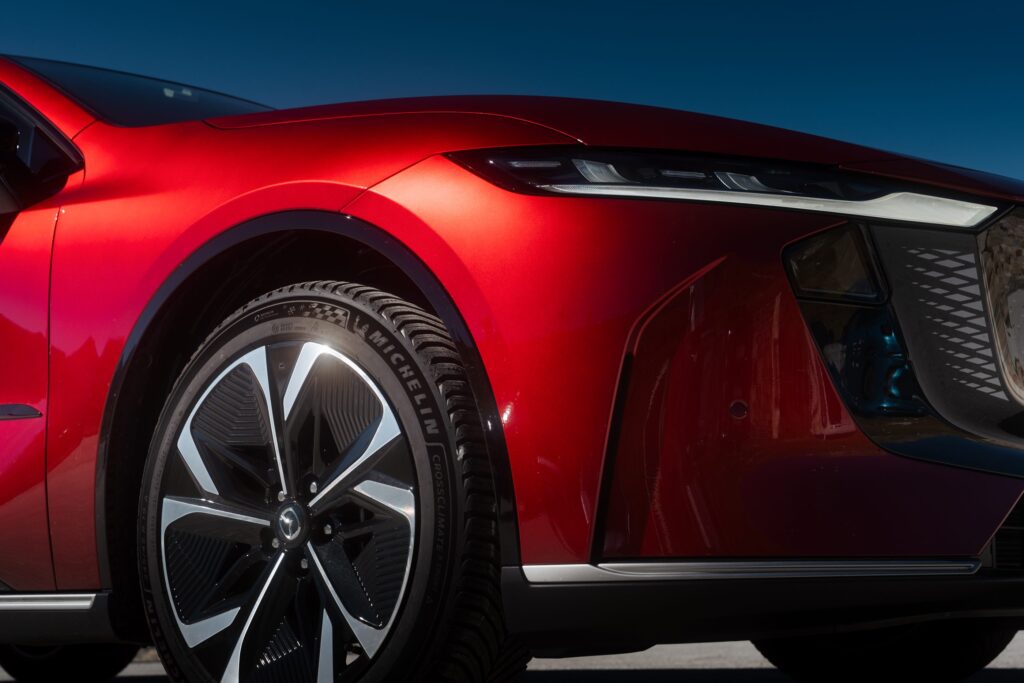
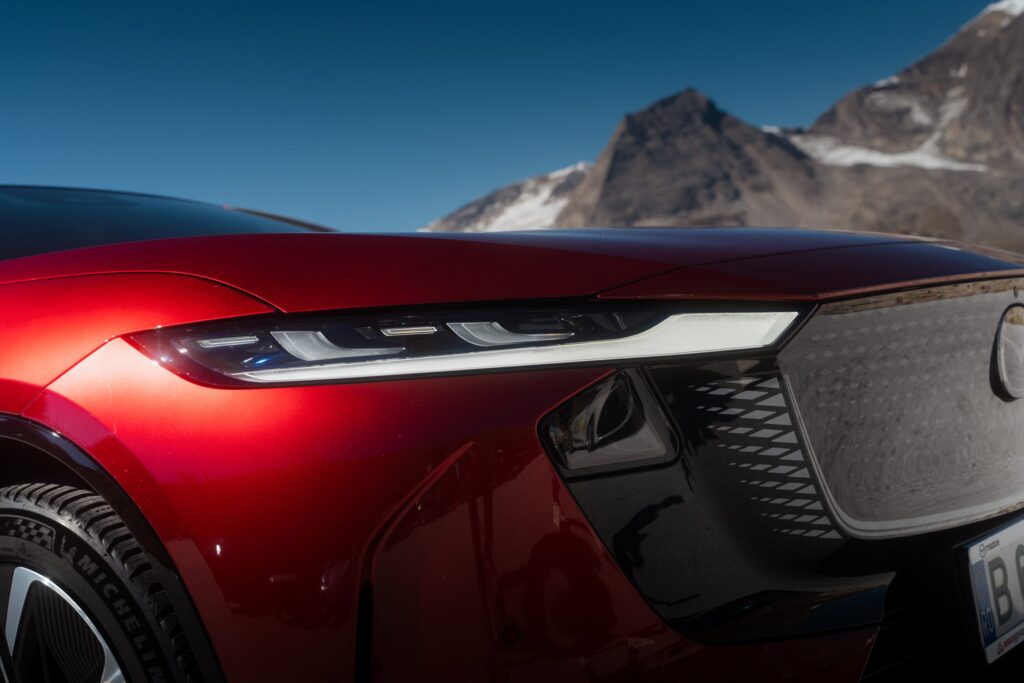
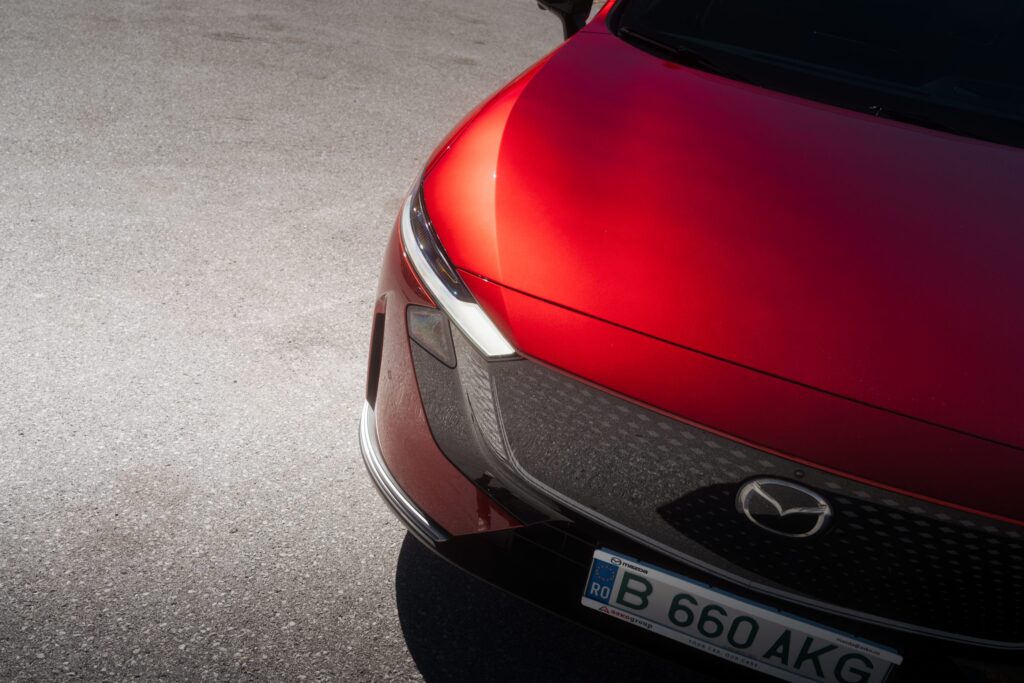
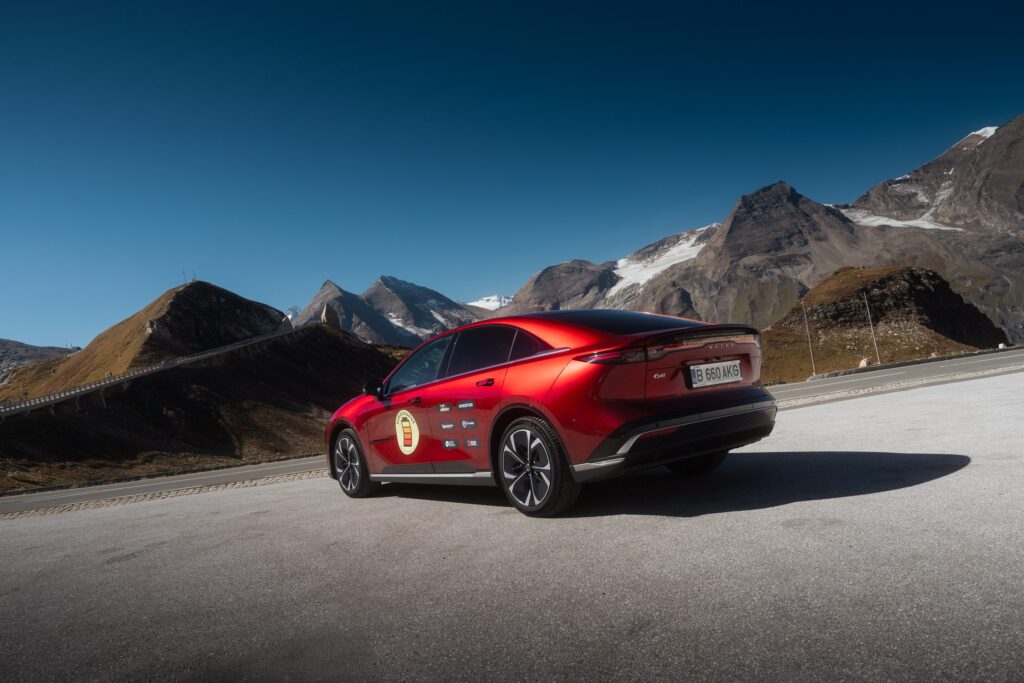
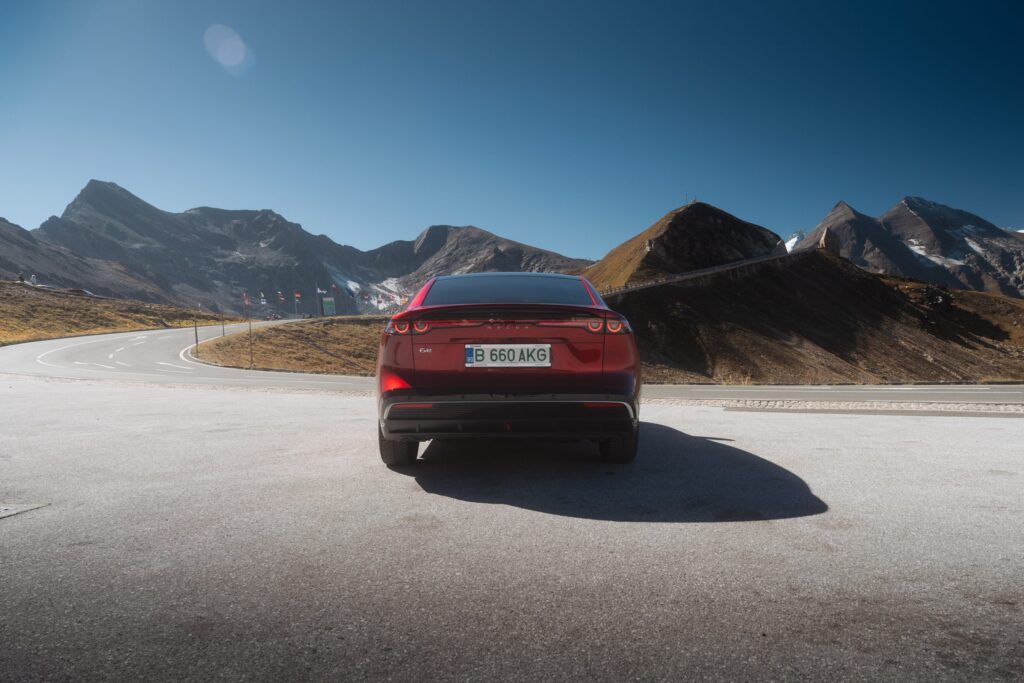
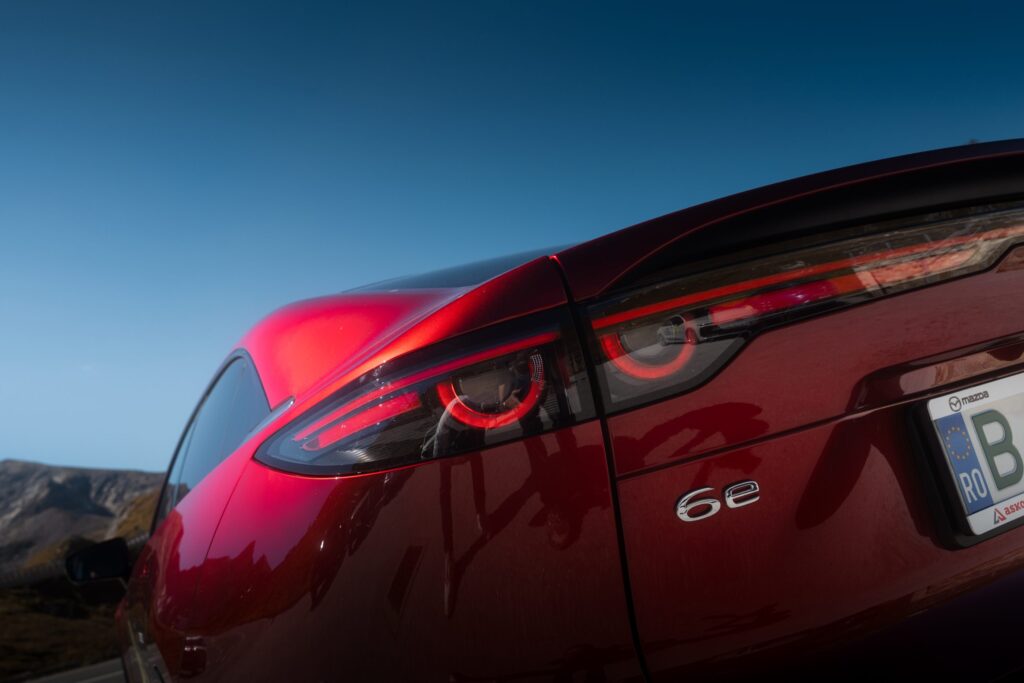
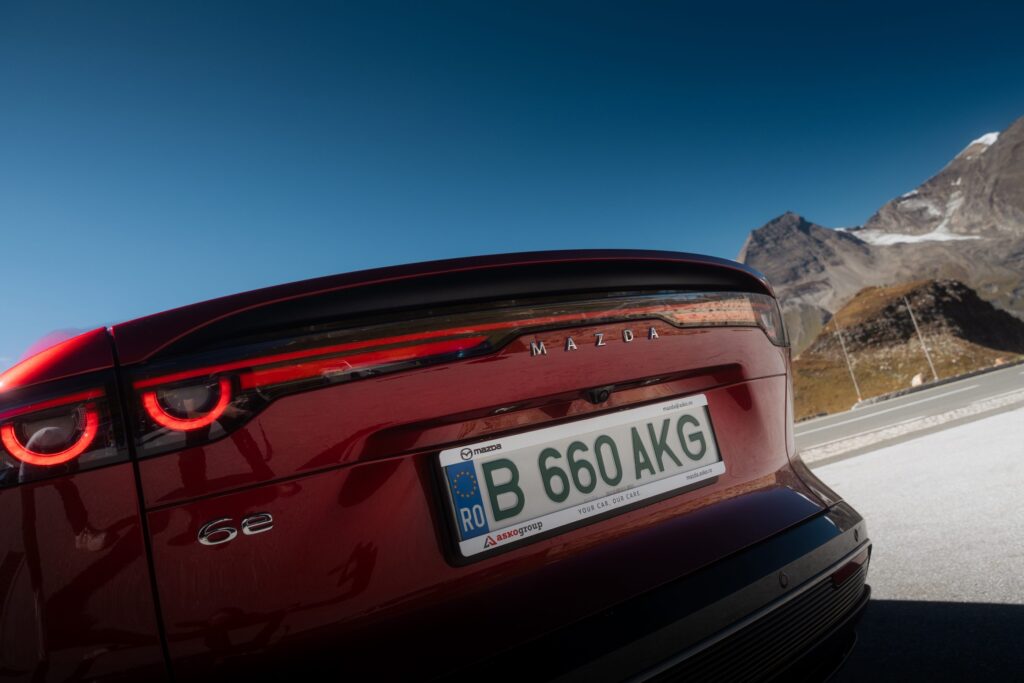
Conclusions and observations
- Beauty and efficiency: Considered by many to be the most beautiful car on the tour, the Mazda 6e has shown that spectacular design can be combined with remarkable efficiency. The weighted average fuel consumption of 18.6 kWh/100 km is an excellent result.
- Highway performance: It handled the longest day (1102 km) with flying colors and an energy consumption average of 19.1 kWh/100 km, proving that it’s a capable endurance cruiser, not just a show car.
- The specialist of short and technical days: It shone on alpine passes, where it managed to cover routes of over 300-500 km with only one short charging stop, thanks to its excellent efficiency (energy consumption of 15.3, 16.3, 16.7, 17.8 kWh/100 km).
- Good charging speed: With an average charging time of under 28 minutes, the Mazda 6e took advantage of every fast charging station to minimize charging time.
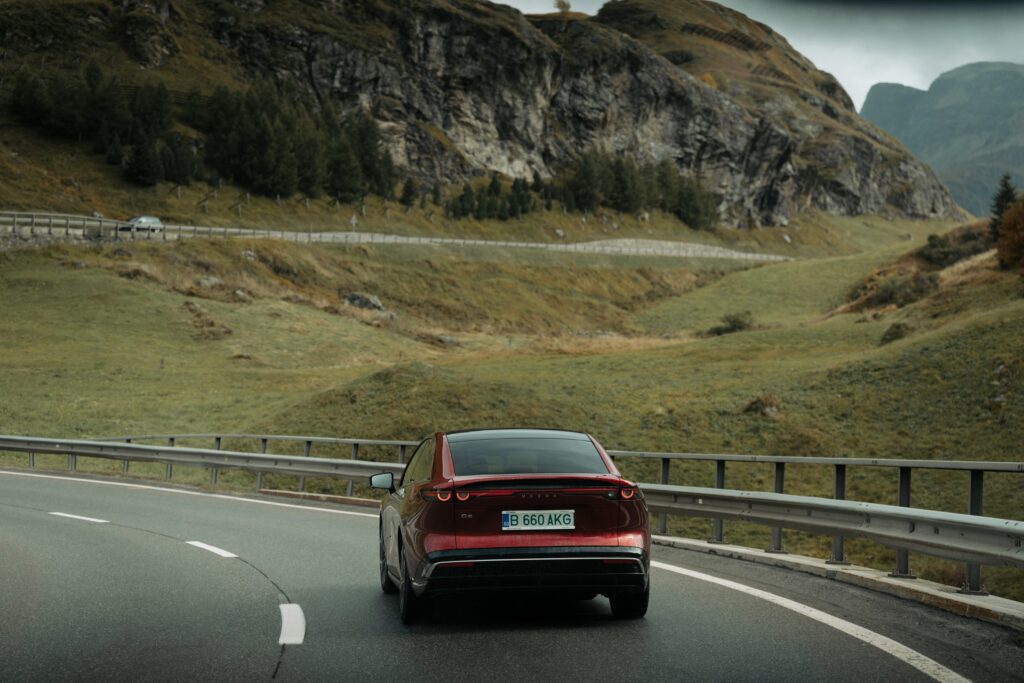
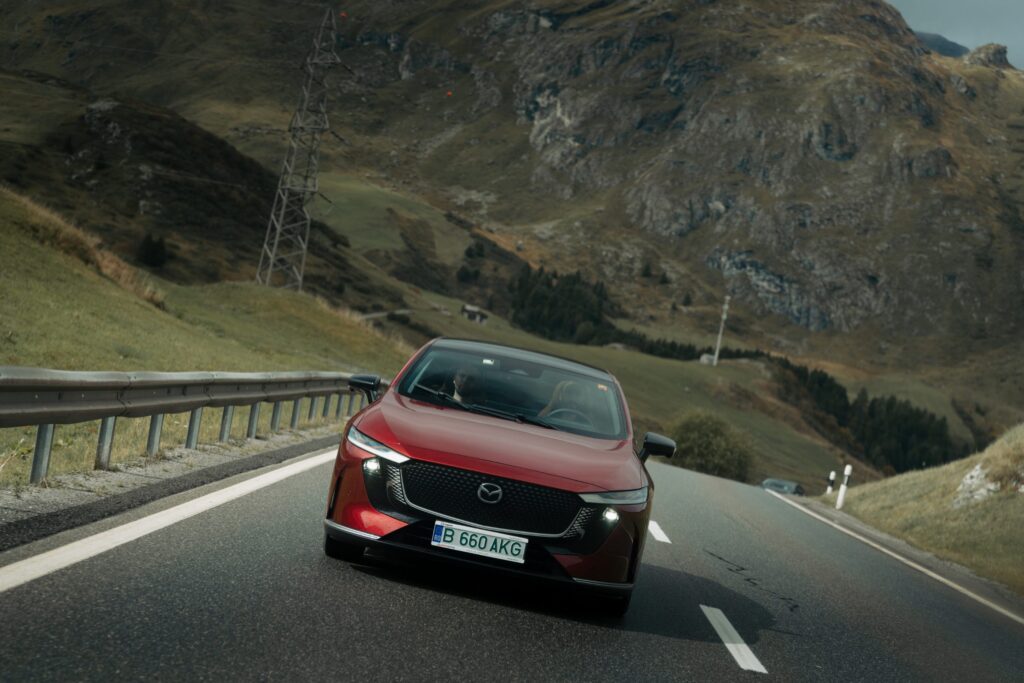
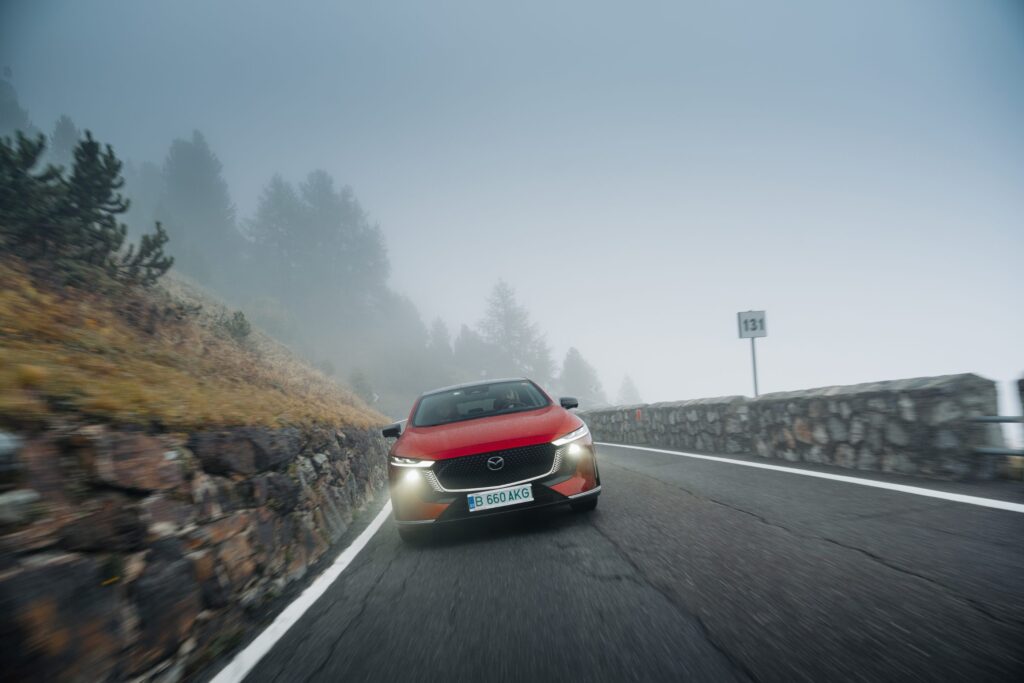
Impressions of those who drove the Mazda 6e in EUROCHARGE by Schaeffler
Constantin Ciobanu (Autocritica, Adevărul Auto)
What if the Mazda6 was rear-wheel drive? For me, it has long been something on the border between curiosity and desire. But it’s happened, now that we’re talking about the Mazda 6e.
First of all I appreciate the fact that you have no difficulty in identifying the new model as a Mazda 6, even with that “e” attached. Then I appreciate the restraint, something that has long characterized the Japanese manufacturer. It would be easy to offer much more, but 258 HP and 320 Nm were enough for me today, even on the Transfăgărășan.
Until a hypothetical ‘MX-5e’, this 6e offers a slightly different recipe. First of all, we’re talking rear-wheel drive, and the fact that the front axle is relieved of the task of sending power to the ground is noticeable. The car is much smoother in the corners, much more relaxed, even though it weighs 2,000 kg. Now, the Michelin CrossClimate 3 Sport tires may well have helped build that feedback. If you opt for the first regenerative braking level, one that somewhat mimics the engine braking of a naturally aspirated engine, you’ll find that this helps the rear end follow the front axle much more fluidly. The car pivots naturally in corners. I loved the throttle pedal, as you can very easily maintain a constant speed without suffering from the on/off switch syndrome.
The suspension has two things going for it: it manages to make the car feel about 300 kg lighter, and it makes sure you enjoy a comfortable ride.
Extra points for the extremely well soundproofed interior, allowing you to enjoy the Sony audio system. Did I mention the interior? Very stylish and spacious.
I didn’t get along so well with the lane-keeping system. Way too stubborn, down to the level of conflict when it comes to what it wants versus what you want. A bit tiresome this battle. I haven’t figured out how to disable it, because I’ve done so with other systems that were quite annoying. For example, the voice assistant can be set to wake to life on the first syllable it hears. Even if you’re talking on the phone, it will still want to fulfill a wish.
All it all, at the end of the day the dashboard showed an average consumption of 19.6 kWh/100 km. A good value for a highway run under temperatures in the 14-16 degrees Celsius range.
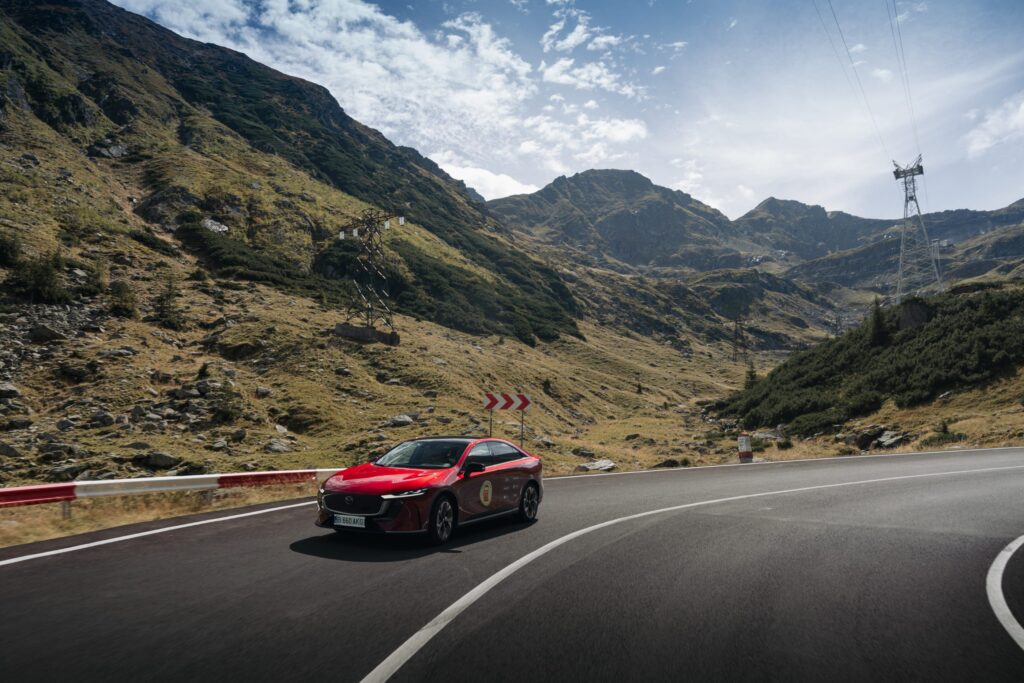
Radu Gurămultă (Autocritica)
Honestly, I’m quite sorry to have come across the “new Mazda6” on the second day of the tour, because, I dare say, probably the most spectacular interior interaction of this project has already been sealed.
The new Mazda 6e not only has the most beautiful and well-thought-out interior in our group (sorry, Porsche, I betrayed you), but I dare to place it next to (and even above) models with much higher statuses – the likes of Audi A8, BMW 7 Series or Mercedes-Benz S-Class. I feel that many will probably not understand me, but I would like to be judged only after they see the model’s cabin in real life. Superior finishes, a symphony of Alcantara, a hi-fi audio system that really deserves its status (I wish I could convey in writing how imposing Mylene Farmer’s voice sounds inside the car), it seems to me that there was a strong desire to blow people away in terms of interior hospitality.
But it’s not all perfect. To top it all, I came across ergonomic oversights that I found annoying: the driving position, even adjusted to the deepest point, is far, far too high, and this makes it difficult for the driver to have a good view at the top of the field of vision. Then, the rear window is small, and the retractable rear spoiler will still cut into the available slice of rearward visibility. But the most annoying thing – though it seems like a great technological gimmick – is the transfer of essential controls from the analog world to the digital one; so, imagine navigating through the menus to adjust the side mirrors or use the wipers in a different way than when they start automatically. I swear I don’t understand why trivial and logical things need to be complicated.
Otherwise, I can see a lot of positives in the powertrain, even if I didn’t have the right context to take advantage of the solution adopted for the drive axle. I really liked the steering setup, even if its brilliance is overshadowed by the less chiseled interventions of the advanced assistance systems (i.e. the lane keeping assist). There’s room for optimization here. Elsewhere, the interior is quiet thanks to the excellent soundproofing, but above all the refinement of the drivetrain, together with the steering feedback, make any 6e ride like pure joy. They won’t hear this, but I’d really like to thank Mazda’s engineers who were involved in this project.
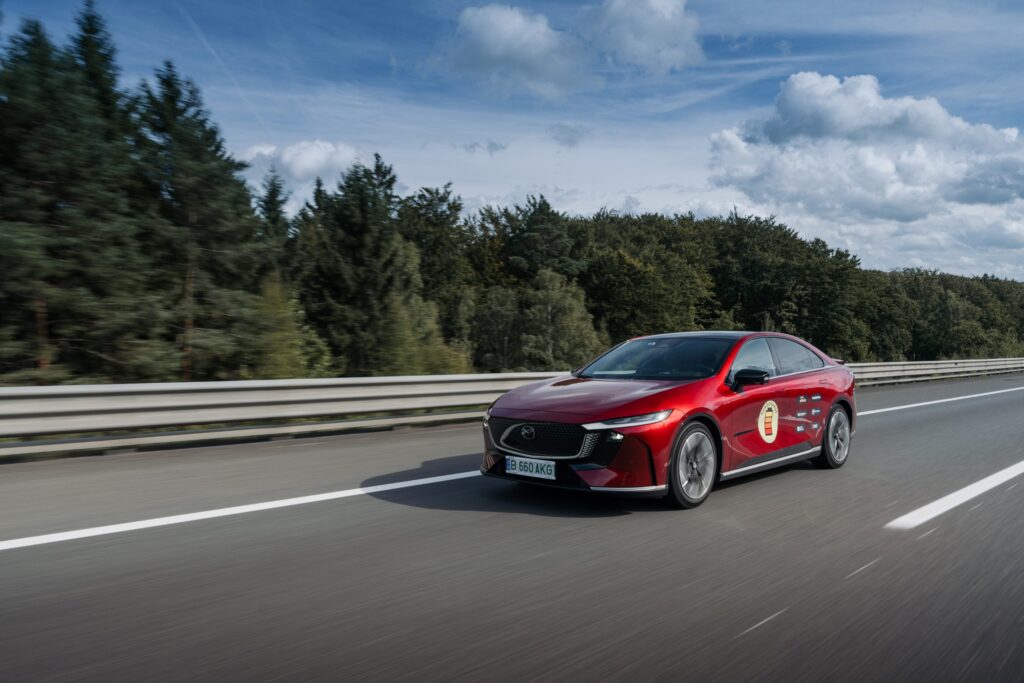
Alin Ionescu (Mașinistul)
After 12 years on the market with a midsize sedan that stayed fairly aloof from the digitization and electrification trends, Mazda has gone straight to a fully electric limousine that marks perhaps the biggest leap ever made by a car from one generation to the next.
The new Mazda 6e isn’t just fully electric, it’s also fully digital. And that, I think, will be the biggest shock for traditional customers. From physical controls, studied ergonomics and minimalist displays, Mazda is moving to a nearly 15-inch touchscreen where all the controls are integrated. Including headlights, wipers, hatch sunshades, everything. But coming from a Tesla, you’ll feel right at home. And you’ll discover a truly premium interior.
In Takumi Plus trim, the 6e really impresses with its beautifully crafted interior, with Alcantara upholstery and cognac-colored faux leather covering the seats, door panels, part of the dashboard and the center tunnel. And it not only looks good, it feels luxurious, solid, well put together.
Returning to the fact that Mazda’s limousine has switched to full-electric power, the version tested in EUROCHARGE, the one with the ‘small’ battery, is probably also the one that will sell best. 68.8 kWh is enough for a real-life range of 300 km, even a bit more in DN or urban driving. But this is the fastest-charging version (max 165 kW), which means that stops of 30 minutes or less are enough to run another 200 km.
It should also be said, at least as a footnote, that this Mazda is made in China, and is based on Changan’s Deepal L07. It’s true that Changan and Mazda have a long-standing collaboration, and the car’s design looks quite natural, with plenty of Mazda-specific details and elements (my favorite being the taillights reminiscent of the RX-7 FD) but some might view this model as carefully disguised badge engineering.
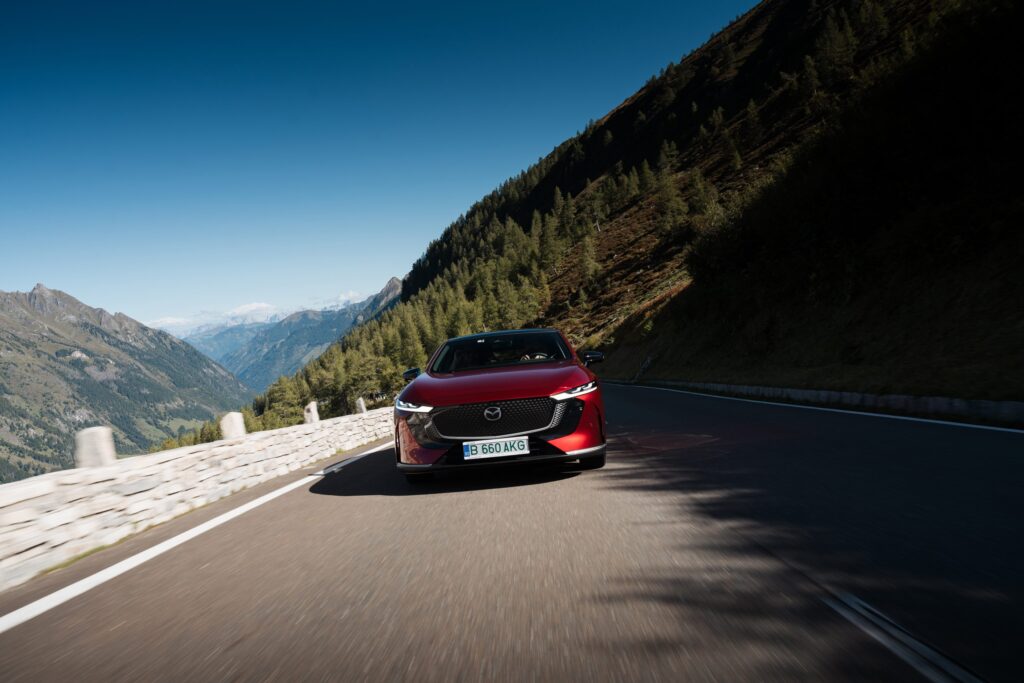
Laura Antonov (LaChicBoutique)
It’s been a long but mostly challenging day (in terms of the route chosen), and the conclusion would be that I’m glad I spent it behind the wheel of the Mazda 6e. Why? Because it’s comfortable, first and foremost – the seats are perfectly supportive and contoured, and the electric adjustments help you quickly find the ideal position to make the journey a pleasure.
All the interior materials give the impression of premium, quality and attention to detail, and are extremely good-looking as well as pleasant to the touch. It is a car you get into with love and curiosity to discover all its secrets. And while we’re on the subject of secrets, I wasn’t thrilled at first glance by the absence of physical buttons – I find it harder in the morning to get into an explorer mood in search of climate, headlight or wiper settings, but during the day I was convinced that the Mazda 6e owner will have no difficulty using it once he’s used to it, they are somehow logically organized and clearly marked.
I like the way it handles corners (the Michelin CrossClimate 3 tires probably help), I didn’t have any qualms about tackling the steep climb to Arosa, which did give us a bit of a fuel consumption problem. At the end of the day, we averaged 16.3 kWh/100 km and only one charge (just enough to walk a few steps and grab a coffee to go from VIVA) over 531 km.
In short, the Mazda 6e wins you over at first glance with its design, convinces you that you’ve made a good choice with the premium materials inside, and isn’t bad on fuel consumption either.
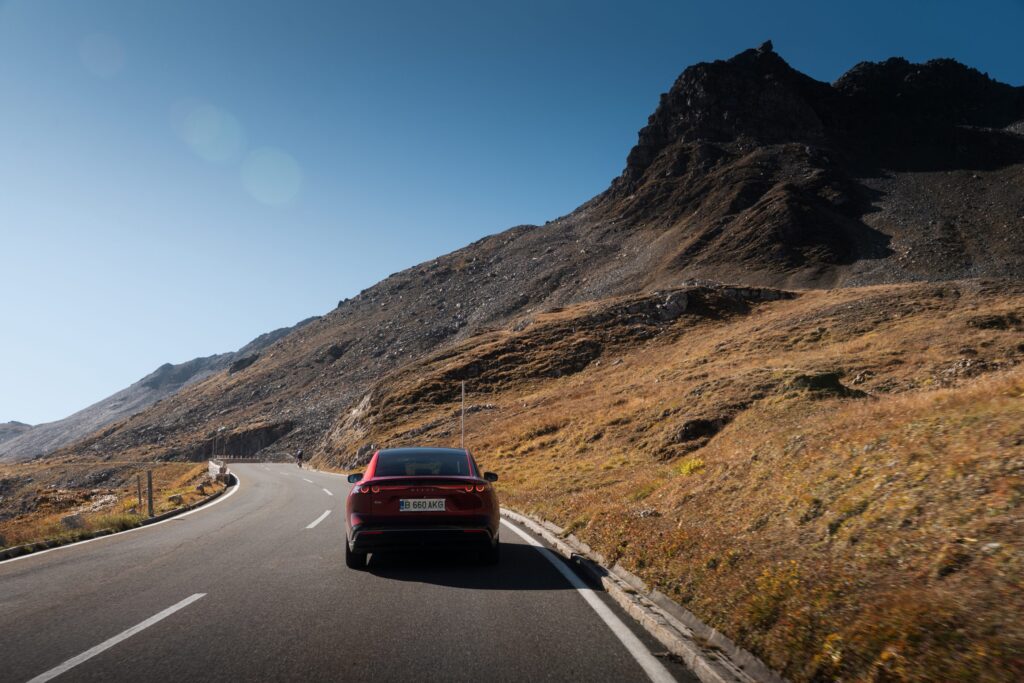
Gabriel Nica (Cu si despre masini)
After 500 kilometers on some of Switzerland’s most breathtaking roads, the Mazda 6e demonstrated its qualities in a setting that took my breath away at times. And it wasn’t because of the thin air. Let’s start with the good bits.
The quality of the interior is without doubt the strong point of this car. The materials used are outstanding and the assembly is impeccable. The surface touch and finishes give a feel that you find on genuine premium models that evolve into entirely different spheres when it comes to the price paid. In fact, I’d say it surpasses them on many occasions.
Another genuine surprise was the road holding. On the twisty roads of the Alps, the Mazda 6e behaved exemplary, demonstrating a very good balance between comfort and sportiness. The car inspires confidence when cornering and the response to the controls is precise and predictable. You can make it oversteer and you’ve certainly never been able to do that in a Mazda6 before. The torque delivered instantly and copiously made me re-evaluate every corner on the climb to Furka pass.
And that’s not all. Charging also worked as it was supposed to. In just 17 minutes we added over 200 kilometers of range – a performance that should take some of the worry off the autonomy of some who think electric cars are just about driving to the Mall and back.
What about the design? I think it’s obvious that it’s the best looking car on this tour, right? Or maybe just to me. It’s okay, I accept that.
But not everything is perfect. While the new Mazda6e is a step up in size, some of the modern car’s shortcomings have made their way on board. Ergonomics unfortunately suffer, with many controls being moved to the ubiquitous screens found in cars today. The driving position isn’t ideal either, with the driver’s seat positioned a little too high for me at 184 cm tall.
Still, Mazda’s new electric sedan is likely to prove a hit. Why? Well take a look at it! That’s all you have to do. And the performance combined with the eye-catching shape and especially the Soul Crystal Red color will be decisive.
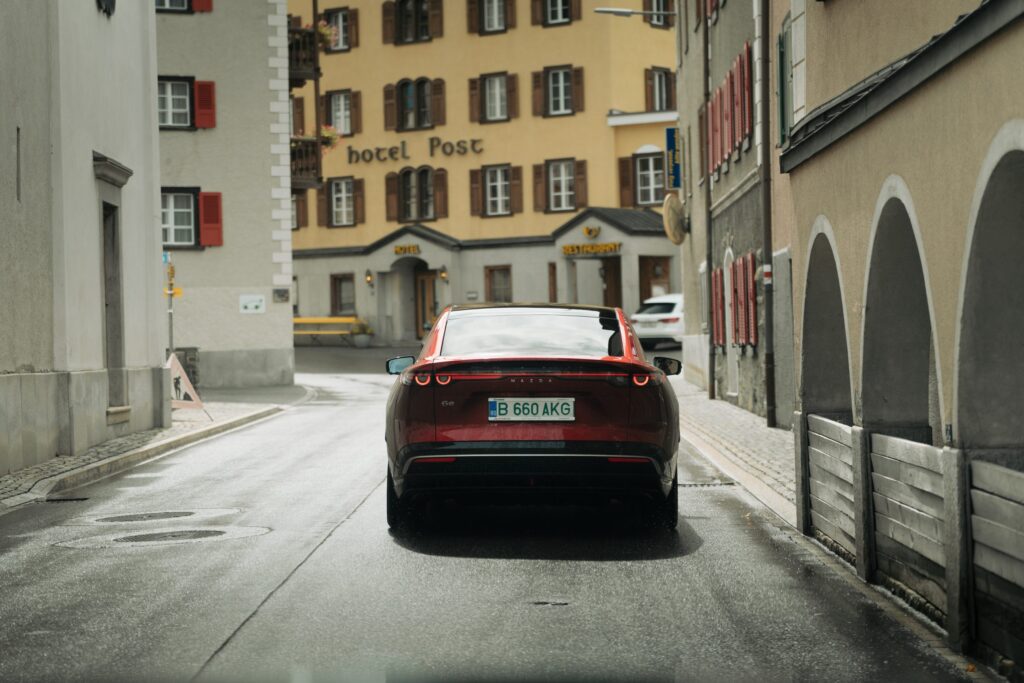
Cornel Șocariciu (Autocritica)
For me, the Mazda 6e remains a paradox. And I’ll explain. In the few hundred kilometers where our lives have crossed (whether it was the Stelvio Pass or the Swiss roads), the Japanese model left me with the impression that it carries on the Mazda tradition: very good dynamic behavior. With all that that means: from the steering to the suspension, from how it responds under acceleration to the atmosphere inside. And yet, the modernity the Japanese have imprinted seems to have been taken to a new level for Mazda. And that’s where the little ‘games in the bearings’ come from. The Japanese ergonomic artists have brought many of the usual controls to a screen: from the mundane mirror controls to folding/unfolding the sunroof sunshade. And it’s not that I don’t like it or don’t like it, but the job might be penalized by a prospective European Mazda buyer. Also, I’m not saying others haven’t done it before, just that it doesn’t seem at all in the Mazda spirit to me.
Now that that’s out of the way, I’d like to talk a bit about the interior materials. In the configuration we’re driving in EUROCHARGE, the Mazda 6e could always show up in a premium car showroom. Not only would it not be sent home on foot, but I think it would get a place among the prize winners. That would be the parallel.
I’d like to come back a little bit to the driving dynamics. The horse and rider connection, the story that Mazda adds to every model in the range, felt strong. What’s more, the 6e managed to remind me that no matter how much energy it puts the wheels in motion, a car should bring a smile to your face at least once in a while. Whether it’s after you’ve taken a hairpin on the Stelvio, or you feel it as soon as you cut along St. Moritz, one of Europe’s most famous mountain resorts.
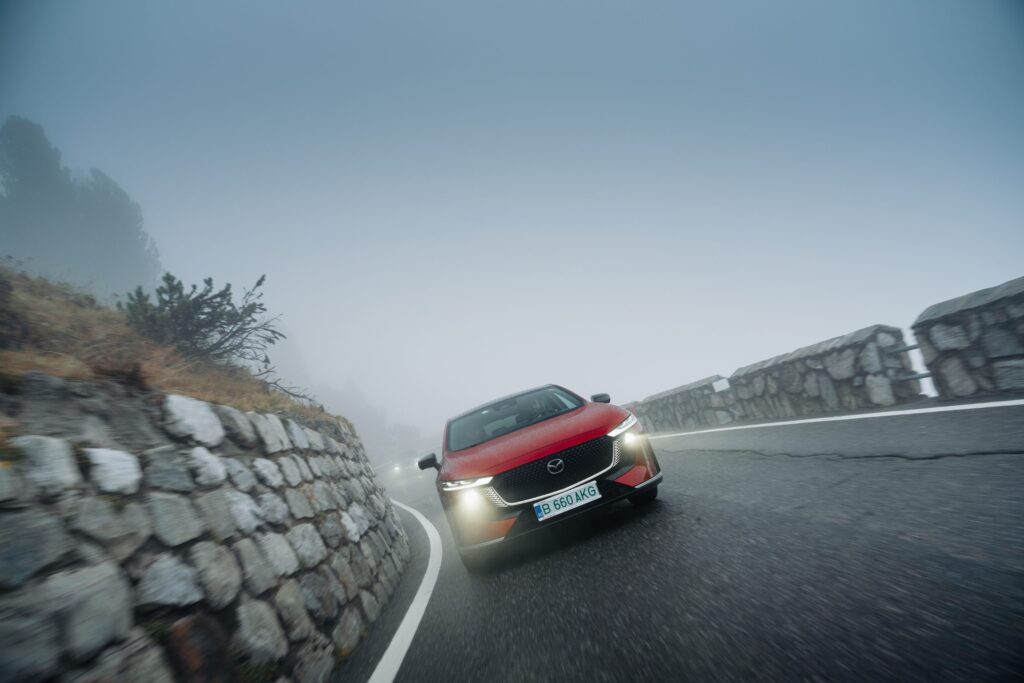
Marco Badea (Explicativ.com)
I drove the Mazda 6e on the Italian roads, on the highway and through the Dolomites. Behind the wheel of this car, I relived my childhood, when I was playing NFS Carbon and driving a red Mazda, like this one, by taste. Only this time I actually drove a Mazda, and a fully electric one at that.
It’s good on the road, it’s lively, and the head-up display is worth every penny for helping me to maintain driving consistency and adjust speeds within the legal limits indicated by the speedometer in good time.
I like the way the car feels to drive, although I’d tweak the suspension a bit and make it stiffer so it doesn’t wallow so much on steeper bumps.
The interior is nice, tasteful, but the dashboard feels like it would be ok to be more intuitive, and the charging ports, which are hidden under the delineation between the driver and right passenger, I think should be put in a more easily accessible place.
Otherwise, the Mazda 6e is a car with personality. That’s how it felt to me. And the range makes it a car to consider if you want to buy something fully electric. The 258 horsepower helped us admire the Dolomites from all angles, and the 66 kWh battery gave us an actual measured range of 395.2 km with an average consumption of 16.7 kWh/100 km.
On the 317-km journey, we made one charging stop, at Passo Gardena in Italy, where the Mazda 6e charged from 36% to 100% in 53 minutes (charging coincided with lunch), with 49 kWh consumed and a cost of €19.39. Overall, I enjoyed the experience behind the wheel, but I would dare to say that the infotainment system could do with an update, especially the climate control.
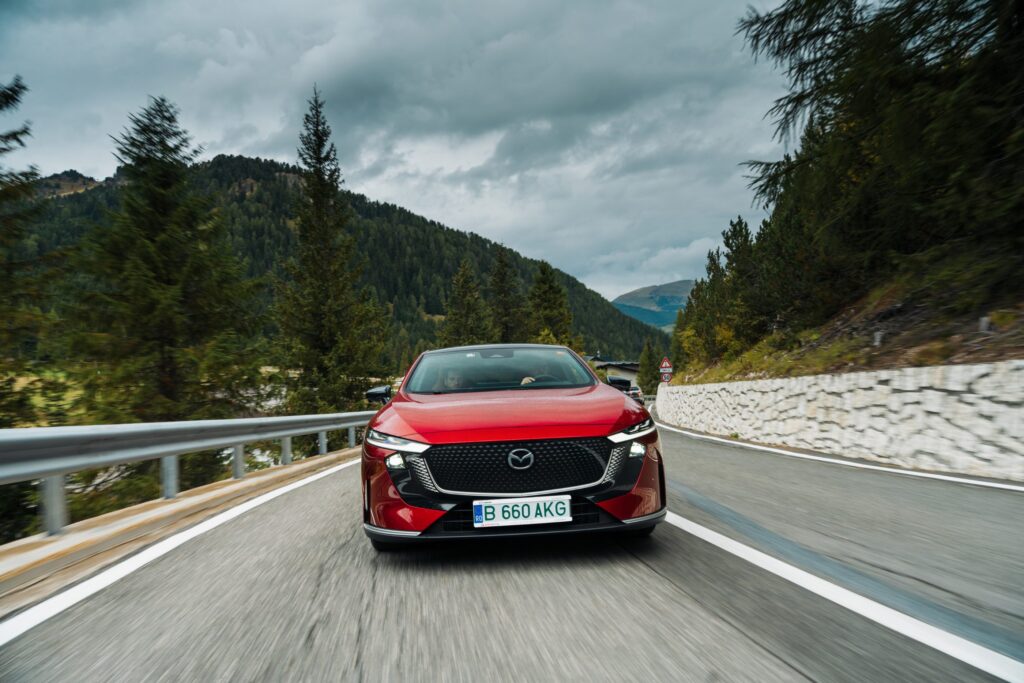
Mircea Mester (Autocritica)
On our road trip in the Alps we had cars big, small, powerful, efficient, comfortable, sporty, all shapes and sizes. In this picture, the Mazda 6e is like a state in state, a kind of special judges’ award, a category in it of itself. I don’t know if it’s the color, Soul Red Crystal, which looks like it’s been applied in 70 layers by a Tibetan monk (I met a group of Tibetan monks on Grossglockner Hochalpenstrasse, by the way), or simply the design, but this car stops pedestrians in their tracks. It is, without any hesitation, the most beautiful car in EUROCHARGE by Schaeffler. I proclaim it here, with the power of the full 22 years of automotive journalism that have flashed before my eyes.
Usually, after such a successful exterior, you expect the interior to be a disappointment, a promise unfulfilled. Except not here. In our top trim, with that cream interior and Alcantara stretched generously across the dashboard and doors, the cabin is a work of art. You kind of want to take your shoes off when you get in. It’s the kind of space that makes some airlines’ business class cabins look low-cost. The perceived quality is fabulous.
Everything is almost perfect. Almost. Because no matter how much you lower the driver’s seat, you’re still sitting a little high. It’s a driving position borrowed from an SUV, which many people will like, but it doesn’t quite match the car’s feline allure.
But how does it drive? I had it on the longest and most harrowing day of the tour: 1,160 kilometers of highway from Italy to Hungary. And I liked it, because it tries so hard to be a real Mazda, a dynamic achievement. The steering is well balanced, the suspension is calibrated between comfort and sportiness, and on the road it feels settled, even mature – it feels like a fourth-generation EV, not like the first.
On the minus side, I noted the lane-keep system, which is such a zealous assistant that it yanks the steering wheel out of your hand even when you signal to change lanes. It’s like an over-enthusiastic bodyguard who also protects you from friends. Fortunately, it can be disabled and I’m sure an OTA update will send it on the right track.
You’ve got two batteries. The small one (69 kWh) charges quickly, at 200 kW. The large one (80 kWh) charges slowly, with 95 kW. Logically, it would have been the other way around, but who are we to judge the decisions made in Hiroshima? We tested the fast-charging version. The result, after almost 1,200 km of highway driving: an average consumption of 19.1 kWh/100 km and a real calculated range of 345.5 km.
For a first non-experimental electric model (let’s forget the MX-30 for a moment), I’d venture to say that Mazda has created the best Japanese electric car on the market. Period. Which is absolutely commendable in the context of Mazda being a rather small enterprise compared to the industrial colossus it struggles against in its home country. All in all, in the Mazda 6e you’ll find a gorgeous car with a fabulous interior that drives exceptionally.
